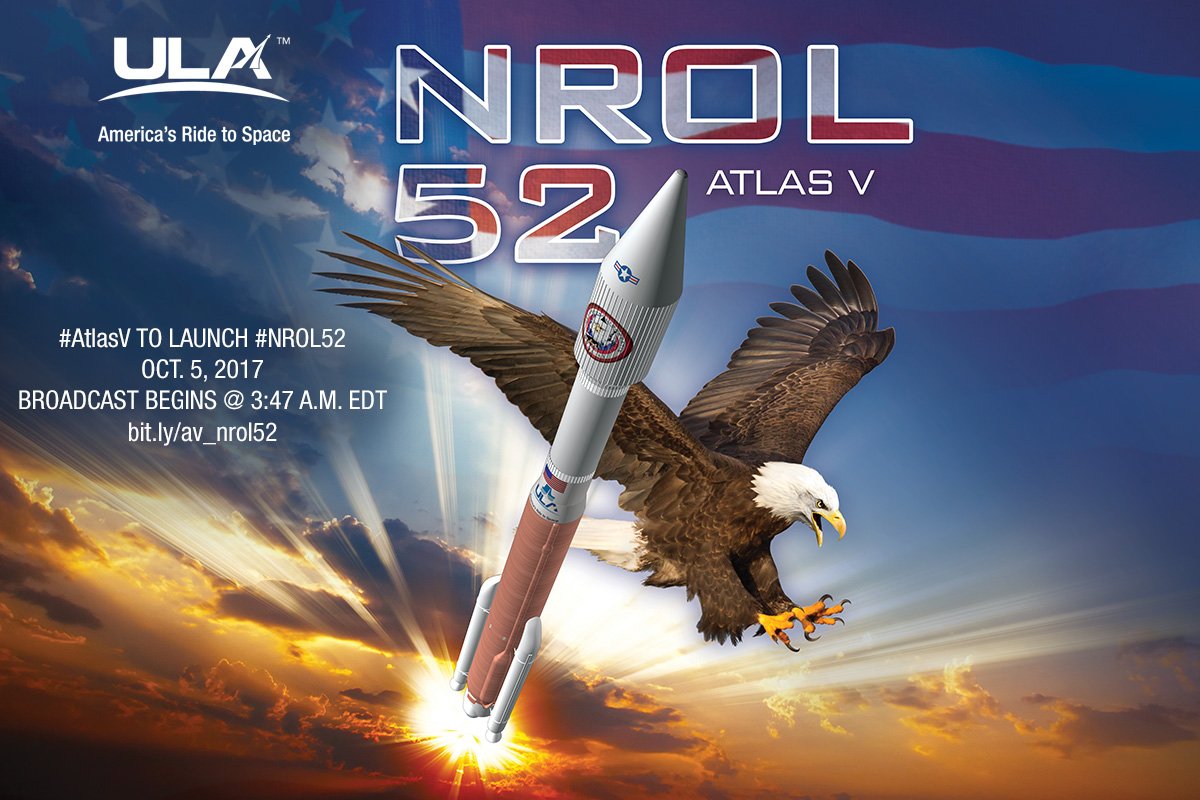After many delays and two scrubbed launch attempts, Boeing’s CST-100 Starliner successfully launched earlier today! The Crewed Flight Test (CFT) took off from Space Launch Complex-41 at Cape Canaveral Space Force Station, Florida, at 10:52 a.m. EDT (07:52 PDT) atop a ULA Atlas V rocket. For this mission, the capsule is carrying two NASA astronauts: Barry “Butch” Wilmore (commander) and Sunita “Suni” Williams (pilot). They are expected to reach the International Space Station (ISS) at 12:15 p.m. EDT (09:15 a.m. PDT) on Thursday, June 6th.
Continue reading “Starliner Finally Launches, Carrying Two Astronauts Into Orbit”October Launch Trifecta from Florida Cleared as SpaceX Conducts Static Fire Engine Test for Oct. 30 KoreaSat Liftoff
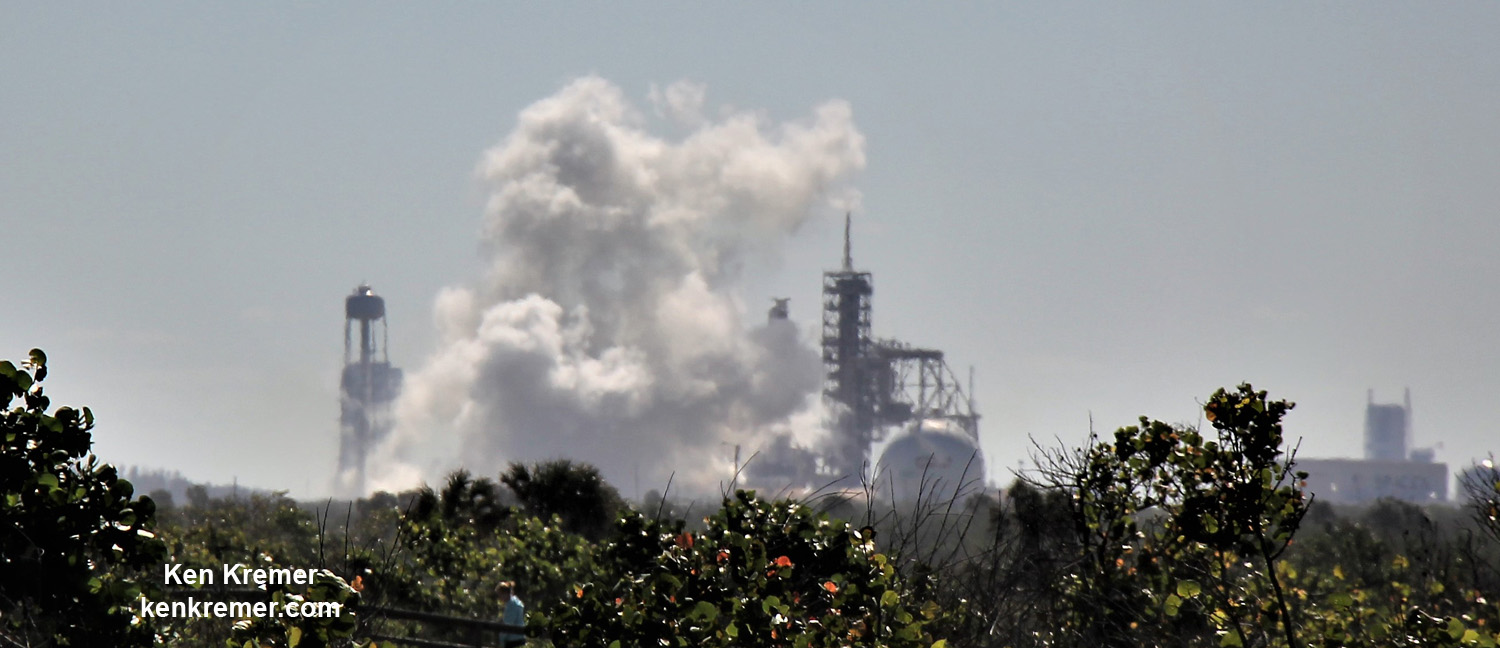

PLAYALINDA BEACH/KENNEDY SPACE CENTER, FL – The path to an October launch trifecta from Florida’s Spaceport was cleared following SpaceX’s successful static fire test of the Falcon 9 boosters first stage engines this afternoon, Oct. 26, and thereby targeting Monday, Oct. 30 for blastoff of the KoreaSat-5A commercial telecomsat.
KoreaSat-5A is being launched by SpaceX under a commercial contract for South Korean operator KTSAT (a KT Corporation company) using a new first stage and will provide Direct to Home (DTH) broadcasting services.
If all goes well, the end of October KoreaSat-5A liftoff will count as the third rocket launch this month from the sunshine states increasingly busy Spaceport following two earlier launches carried out by both ULA and SpaceX.
Those two mid-month missions involved the commercial SES-11/EchoStar 105 UHDTV satellite on a SpaceX Falcon 9 and the covert NROL-52 spy satellite delivered to orbit on a ULA Atlas V respectively on Oct. 11 and Oct. 15.
The brief engine test of the two stage Falcon 9 took place at 12 noon EDT (1600 GMT) Thursday, Oct. 26, with the sudden eruption of smoke and ash rushing out the north facing flame trench and into the air over historic pad 39A on NASA’s Kennedy Space Center during a very comfortably sunny and windy afternoon – as I witnessed from the crashing waves of Playalinda Beach, FL just a few miles away. See photo and video gallery from myself and space journalist colleague Jeff Seibert.
“Static fire test of Falcon 9 complete,” SpaceX confirmed via tweet soon after the hotfire test was conducted.
“Targeting October 30 launch of Koreasat-5A from Pad 39A in Florida.”
Monday’s mid-afternoon liftoff with the private KoreaSat-5A mission is targeted for a window that opens at 3:34 p.m. EDT (1934 GMT) from seaside Launch Complex 39A at NASA’s Kennedy Space Center in Florida.
The launch window for the virgin booster extends nearly two and a half hours until 5:58 p.m. EDT (2158 GMT).
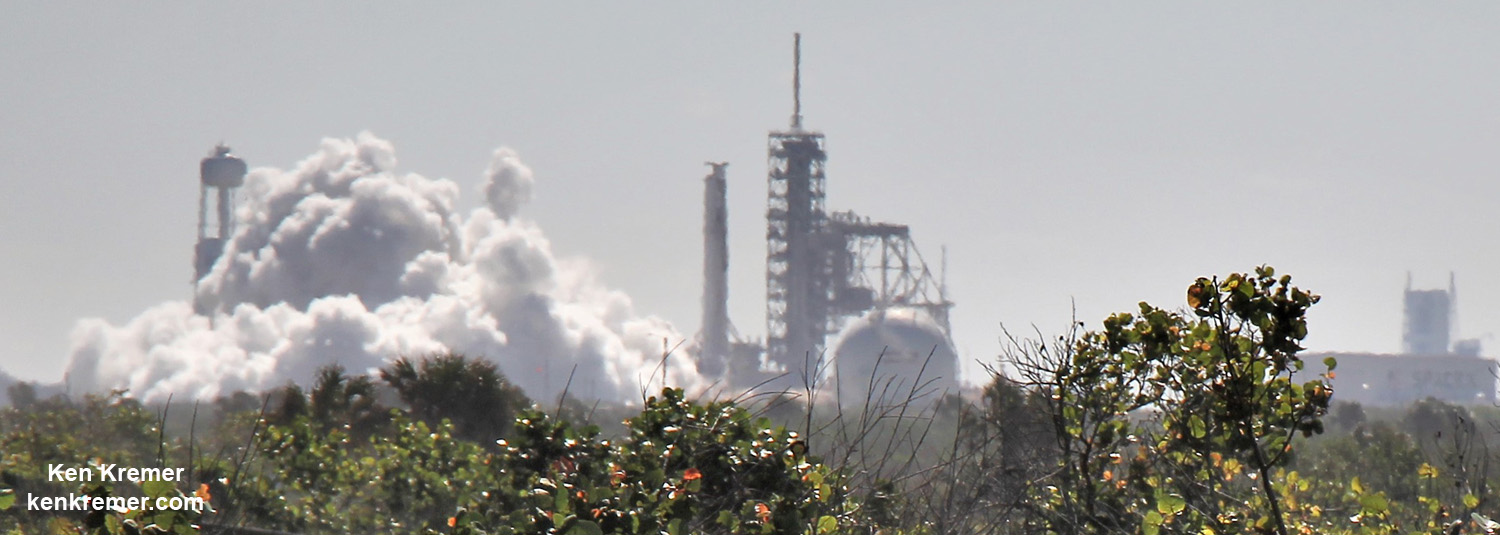
The SpaceX Falcon 9 will deliver Koreasat-5A to a geostationary transfer orbit (GTO).
SpaceX will also attempt to recover this booster by soft landing on an ocean going platform prepositioned in the Atlantic Ocean – about 8 minutes after blastoff.
Playalinda Beach is a spectacular place to witness the launch from – while surfing the waves too – if you’re in the area.
During today’s hold down static fire test, the rocket’s first and second stages are fueled with liquid oxygen and RP-1 propellants like an actual launch, and a simulated countdown is carried out to the point of a brief engine ignition.
The hold down engine test with the erected Falcon 9 rocket involved the ignition of all nine Merlin 1D first stage engines generating some 1.7 million pounds of thrust at pad 39A while the two stage rocket was restrained on the pad.
The static fire test lasted approximately three seconds. The test is routinely conducted by SpaceX engineers to confirm the rockets readiness to launch.
The engines exhaust cloud quickly dissipated within about a minute due to the high winds.
Watch this up close static hot fire test video:
Video Caption: SpaceX Falcon 9 Static Test Fire for Koreasat 5A / Oct 26, 2017. Credit: Jeff Seibert
The engine test was run without the expensive payload on top to keep it safe in case of a launch pad accident as happened during a fueling test last September with the Israeli AMOS-6 payload.
The rocket will now be rolled back down the pad ramp and into the SpaceX processing hangar at the pad about ¼ mile away for integration with the Koreasat-5A spacecraft encapsulated inside the payload fairing.
In this case the SpaceX Falcon 9 will fly as a brand new rocket rather than a reused booster as happened earlier this month for the SES-11 launch.
The launch will be the 16th this year by a SpaceX Falcon 9 rocket.
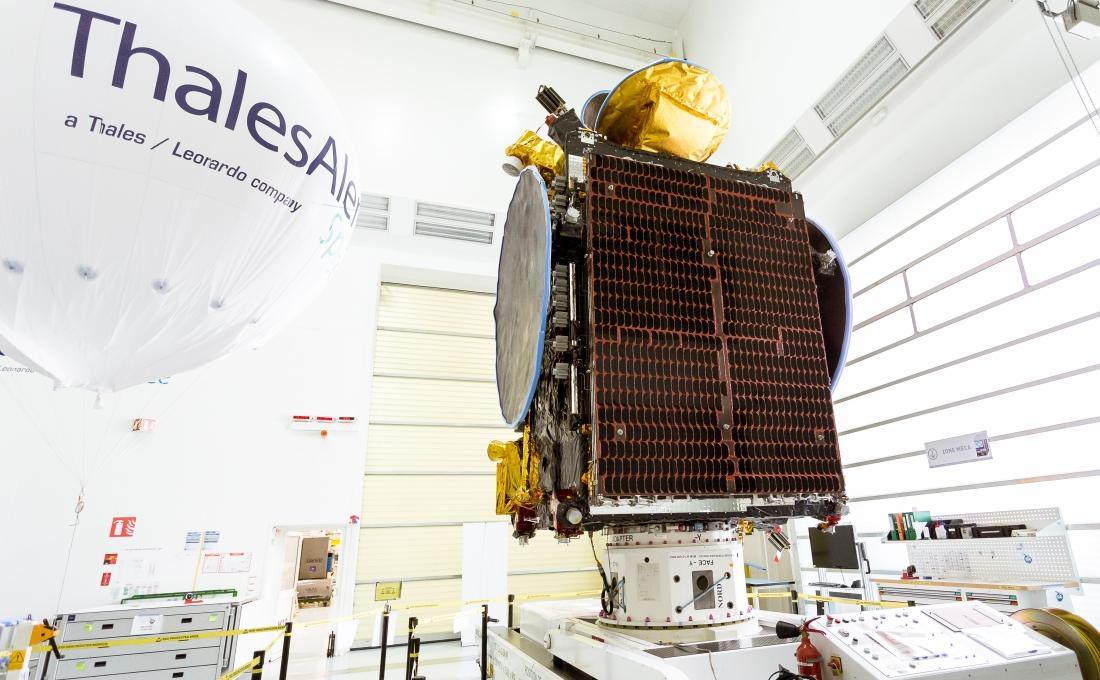
Koreasat-5A was built by prime contractor, Thales Alenia Space, responsible for the design, production, testing and ground delivery. It arrived at the Florida launch base on Oct. 5 for integration with the Falcon 9 rocket.
The 3,700 kg satellite is equipped with 36 Ku-band transponders and based on Thales Alenia Space’s new-generation Spacebus 4000B2 platform. It will replace Koreasat 5.
The solar panels provide a payload power of approximately 6.5 kW. It will be positioned at 113° East and provide coverage for Indochina, Japan, Korea, the Philippines and the Middle East including Direct to Home (DTH) services.
Pad 39A has been repurposed by SpaceX from its days as a NASA shuttle launch pad.
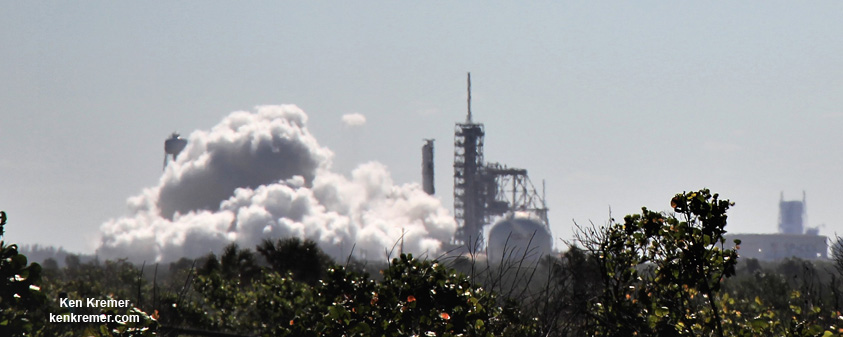
To date SpaceX has accomplished 18 successful landings of a recovered Falcon 9 first stage booster by land and by sea.
The first stage from this months SES-11 launch arrived back into Port Canaveral, FL on top of the OCISLY droneship on Oct. 15.

Watch for Ken’s continuing onsite coverage of SpaceX KoreaSat-5A & SES-11, ULA NROL-52 and NASA and space mission reports direct from the Kennedy Space Center and Cape Canaveral Air Force Station, Florida.
Stay tuned here for Ken’s continuing Earth and Planetary science and human spaceflight news.

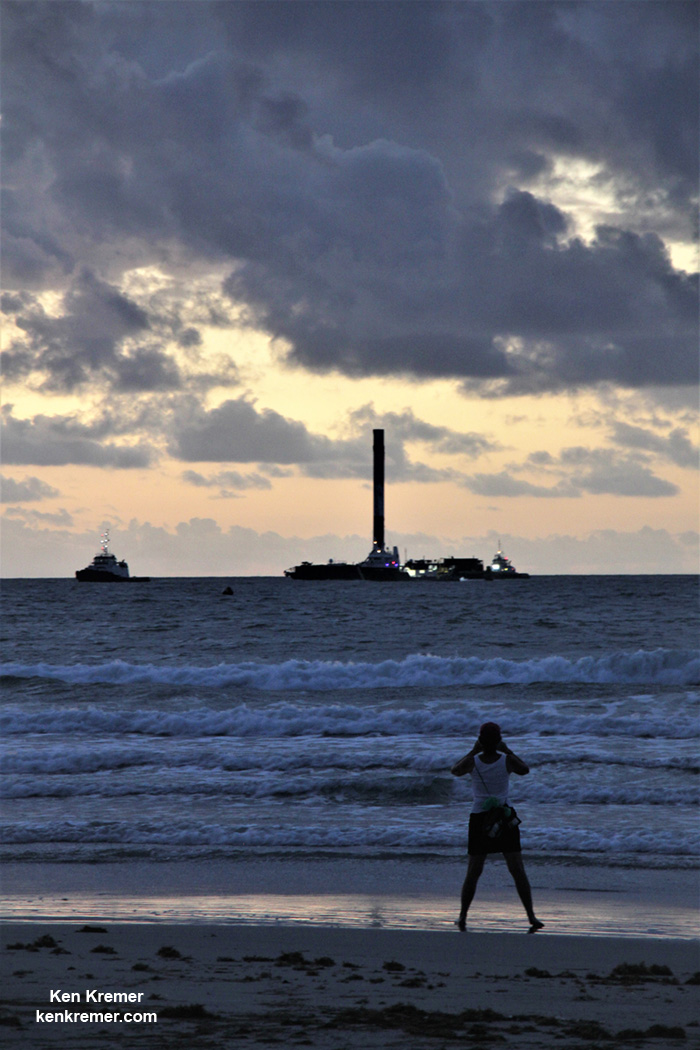
NRO Spysat Set to Kick Off Florida Space Coast Launch Double Header Overnight Oct. 5 on ULA Atlas V: Watch Live
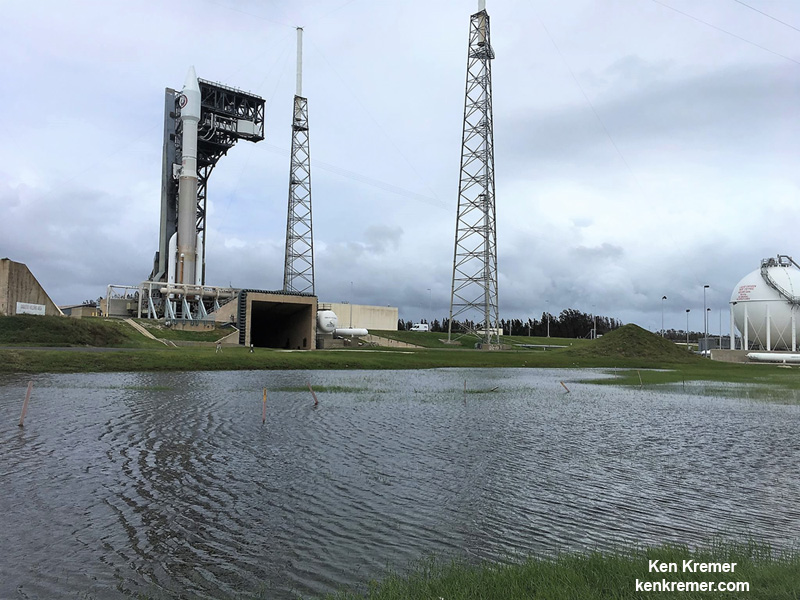

CAPE CANAVERAL AIR FORCE STATION, FL — A classified spy satellite for the U.S. governments National Reconnaissance Office (NRO) is set to kick of a launch double header this week on the Florida Space Coast with what should be a majestic overnight liftoff Thursday, Oct. 5, of a United Launch Alliance (ULA) Atlas V. UPDATE: Rain delay to Fri 10/6 at 403 AM EDT. Reset to 10/7 at 339 AM EDT
A SpaceX Falcon 9 will follow up at dinnertime Saturday, Oct. 7 with a commercial satellite launch if all goes well and the currently unsettled and rainy weather clears out in time.
A ULA Atlas V launch carrying the NROL-52 mission in support of national security is targeted for blastoff Thursday at 4:07 a.m. EDT (0807 GMT) from seaside Space Launch Complex-41 at Cape Canaveral Air Force Station in Florida.
The venerable two stage Atlas V stands 194 feet tall and sports a 100% success record. The first stage will generate approx. 1.6 million pounds of liftoff thrust.
The nighttime liftoff should look absolutely stunning affording space coast region witnesses a spectacle they won’t forget. If it’s not obscured by clouds the launch should be visible for many dozens and dozens of miles away.
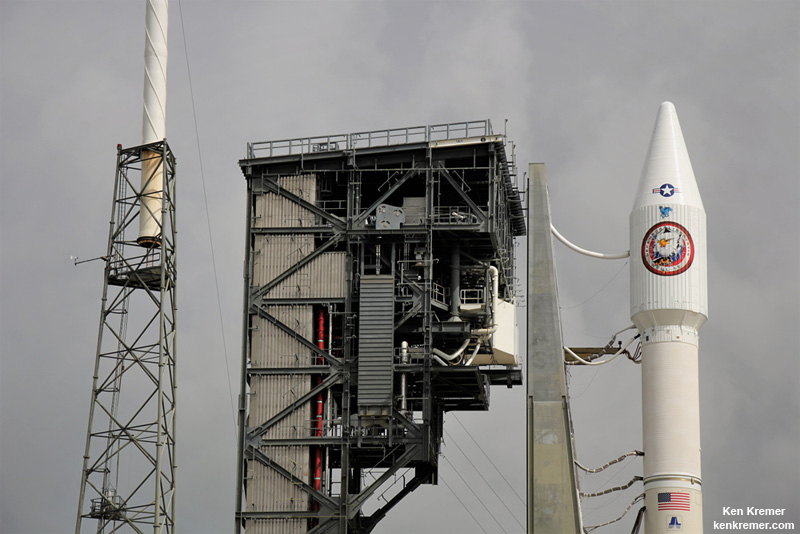
Over the past week the region has seen torrential downpours off and on and many areas have been sporadically flooded.
New temporary lakes have even appeared at pad 41 as I saw during our media visit to set up remote launch cameras today.
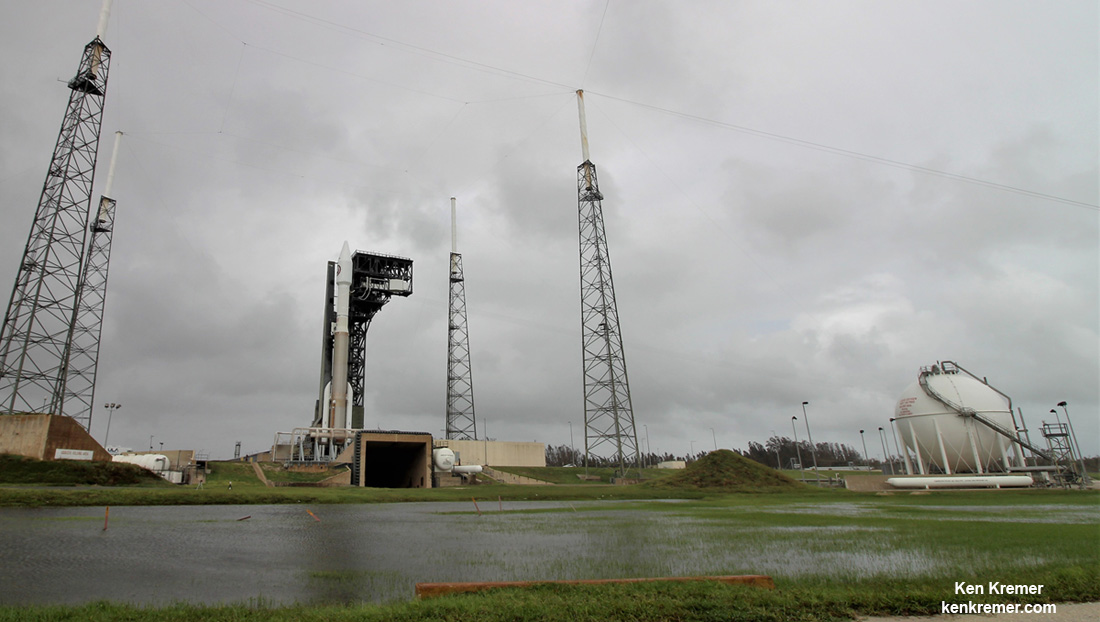
So for space and rocket enthusiasts that’s 2 launches in just over 2 days this week and more than enough reason to come on over.
Both launches were postponed several days in the aftermath of Hurricane Irma which walloped the Kennedy Space Center and Cape Canaveral Air Force Station launch base in early September – shortly after the SpaceX Falcon 9 blasted off with the US Air Force X-37B military mini-shuttle on Sept. 7 from the Kennedy Space Center.
You can watch the Atlas V rocket launch live via a ULA webcast at – www.ulalaunch.com and www.youtube.com/unitedlaunchalliance
The ULA program starts at 3:47 a.m. ET.
The launch window extends for an hour until 5:07 a.m. ET.
In the event of delay for any reason, the next launch opportunity is Friday, Oct 6. The launch time opens several minutes earlier on Friday.
The rocket was rolled out to the pad this morning.
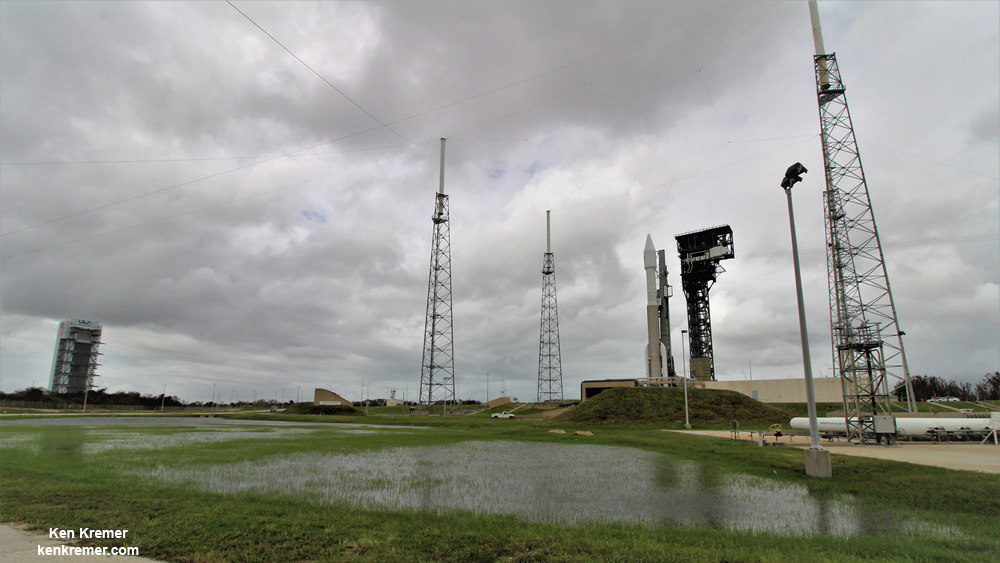
The weather looks iffy at this time with a 60% chance of favorable conditions at launch time according to U.S. Air Force meteorologists with the 45th Space Wing Weather Squadron at Patrick Air Force Base. The primary concerns on Oct 5 are for Cumulus Clouds and Ground Winds.
The odds drop to 30% favorable for the 24 hour scrub turnaround day on Oct. 6.
This is ULA’s second NRO launch using an Atlas V rocket in the past two weeks. NROL-42 launched from Vandenberg AFB, Ca. on September 24, 2017.
Unlike most classified launches the launch time for the NROL-52 payload has been announced ahead of time.
Otherwise virtually everything about the clandestine payload, its mission, purpose and goals are classified top secret and it is certainly vital to America’s national security.
The NRO runs a vast fleet of powerful orbital assets hosting a multitude of the most advanced, wide ranging and top secret capabilities.
NROL-52 is being launched for the NRO on an intelligence gathering mission in support of US national defense.
The possible roles for the reconnaissance payload include signals intelligence, eavesdropping, imaging and spectroscopic observations, early missile warnings and much more.
This ULA video profiles the NROL-52 launch:
The Atlas V will launch in the 421 configuration. The first stage is powered by the Russian made RD-180 engines and is augmented with two solid rocket boosters. The payload fairing is 4 meters (13.1 feet) in diameter and the upper stage is powered by a single-engine Centaur.
This marks the 6th and final Atlas V launch of the year.
The NROL-52 mission will mark ULA’s seventh launch of 2017 and 26th for the National Reconnaissance Office.
NROL-52 will be the 74th flight of the Atlas V rocket and the seventh in the 421 configuration.
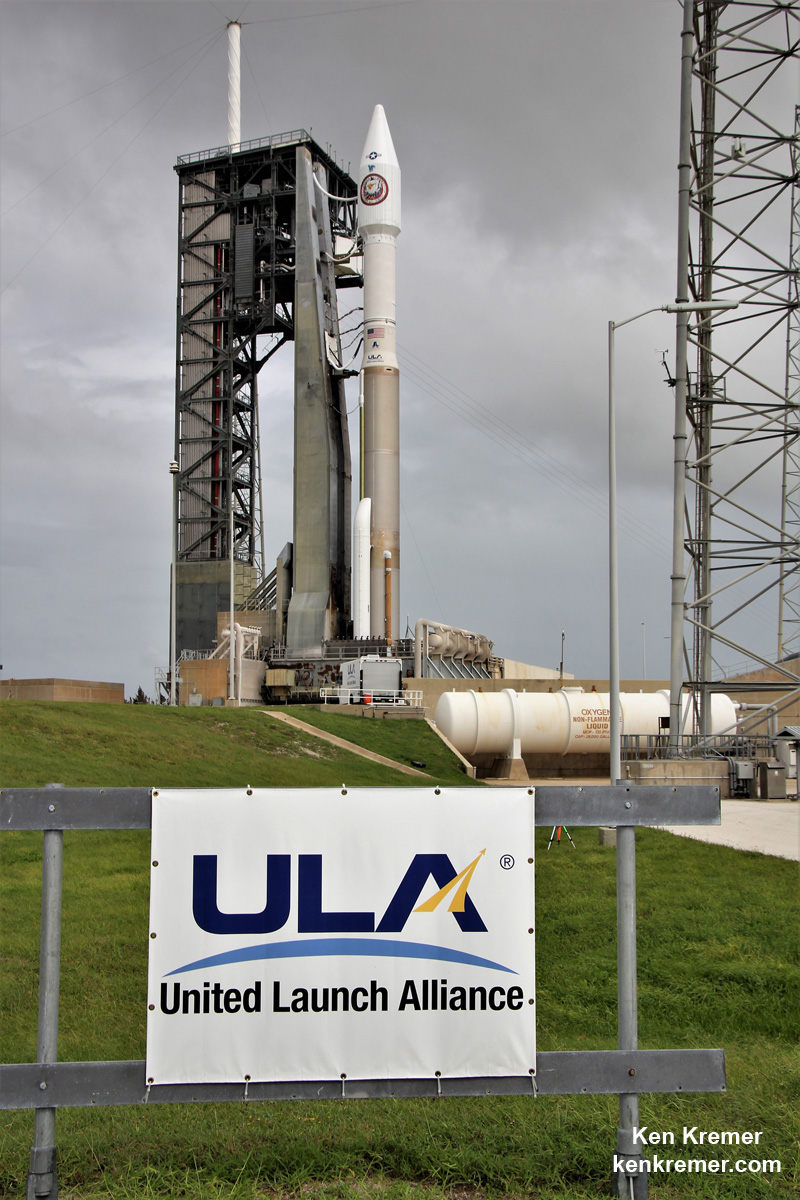
ULA Atlas V rocket will deliver the classified NROL-52 spysat to orbit for the National Reconnaissance Office. Liftoff targeted for 4:07 a.m. ET, Oct. 5, 2017 from Space Launch Complex-41 at Cape Canaveral Air Force Station in Florida. Credit: Ken Kremer/kenkremer.com
Watch for Ken’s continuing onsite NROL-52, SpaceX SES-11 and NASA and space mission reports direct from the Kennedy Space Center and Cape Canaveral Air Force Station, Florida.
Stay tuned here for Ken’s continuing Earth and Planetary science and human spaceflight news.
………….
Learn more about the upcoming ULA Atlas NRO NROL-52 spysat launch on Oct 5 and SpaceX Falcon 9 SES-11 launch on Oct 7, JWST, OSIRIS-REx, NASA missions and more at Ken’s upcoming outreach events at Kennedy Space Center Quality Inn, Titusville, FL:
Oct 4-6, 8: “ULA Atlas NRO NROL-52 spysat launch, SpaceX SES-11, CRS-12 resupply launches to the ISS, Intelsat35e, BulgariaSat 1 and NRO Spysat, SLS, Orion, Commercial crew capsules from Boeing and SpaceX , Heroes and Legends at KSCVC, ULA Atlas/John Glenn Cygnus launch to ISS, SBIRS GEO 3 launch, GOES-R weather satellite launch, OSIRIS-Rex, Juno at Jupiter, InSight Mars lander, SpaceX and Orbital ATK cargo missions to the ISS, ULA Delta 4 Heavy spy satellite, Curiosity and Opportunity explore Mars, Pluto and more,” Kennedy Space Center Quality Inn, Titusville, FL, evenings
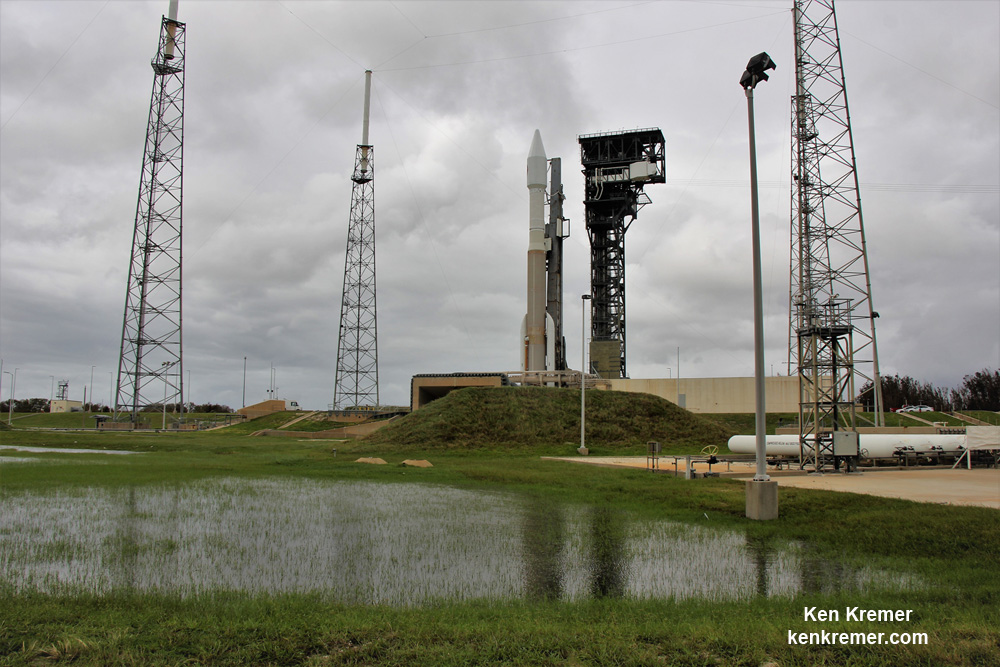
SS John Glenn Stellar Space Station Launch – Photo/Video Gallery
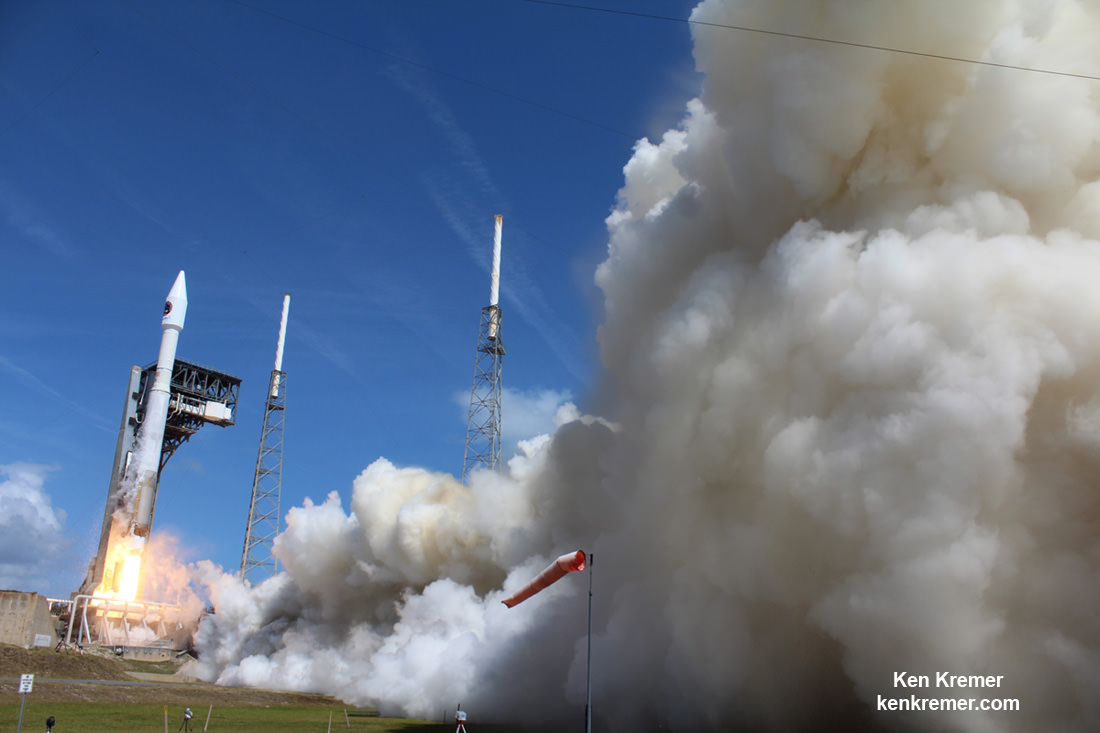

KENNEDY SPACE CENTER, FL – This week’s blastoff of the ‘SS John Glenn’ Cygnus cargo freighter atop an Atlas V rocket on a critical mission delivering over 7000 pounds of science and gear to the International Space Station (ISS) yielded stellar imagery from all around the Florida Space Coast.
On the occasion of what amounts to a sentimental third journey to space for NASA astronaut John Glenn – the first American to orbit Earth – near perfect weather conditions enabled spectacular views of the lunchtime liftoff of the United Launch Alliance Atlas V carrying Orbital ATK’s commercial Cygnus supply ship named in honor of a true American hero.
The SS John Glenn blasted to orbit on time at 11:11 a.m. EDT Tuesday, April 18 atop a United Launch Alliance Atlas V rocket from Space Launch Complex 41 on Cape Canaveral Air Force Station in Florida.
The cargo ship safely reached the station early Saturday morning.
The stunning launch events were captured by journalists and tourists gathered from across the globe.
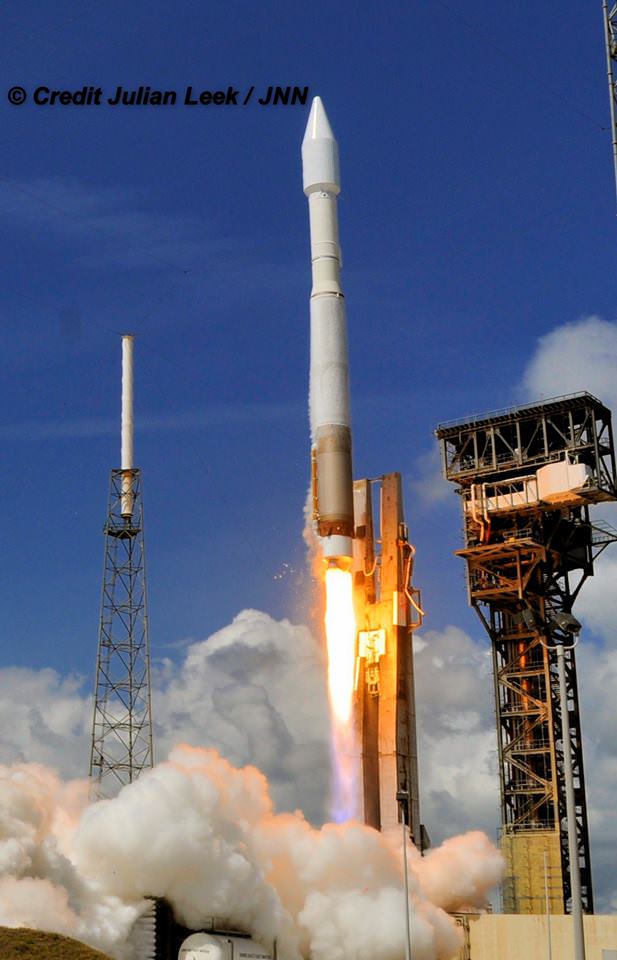
Check out this expanding gallery of eyepopping photos and videos from several space journalist colleagues and friends and myself – for views you won’t see elsewhere.
Click back as the gallery grows !
Watch this truly magnificent and unique video from space journalist Jeff Seibert positioned at a Playalinda Beach on the Atlantic Ocean – as excited vacationers and space enthusiasts frolic together in the waves and sands of this public beach.
Video Caption: Launch of Orbital ATK OA-7 Cygnus cargo vessel viewed from Playalinda Beach, FL on April 18, 2017. An Atlas 5 rocket launching a Cygnus cargo vessel, the “S.S. John Glenn” to the ISS loaded with 7452 pounds of science equipment, experiments, consumables and spare parts. Credit: Jeff Seibert
Playalinda is located just north of NASA’s Launch Complex 39A and offers the closest and clearest possible views of Atlas rocket launches from only about 5 miles away.
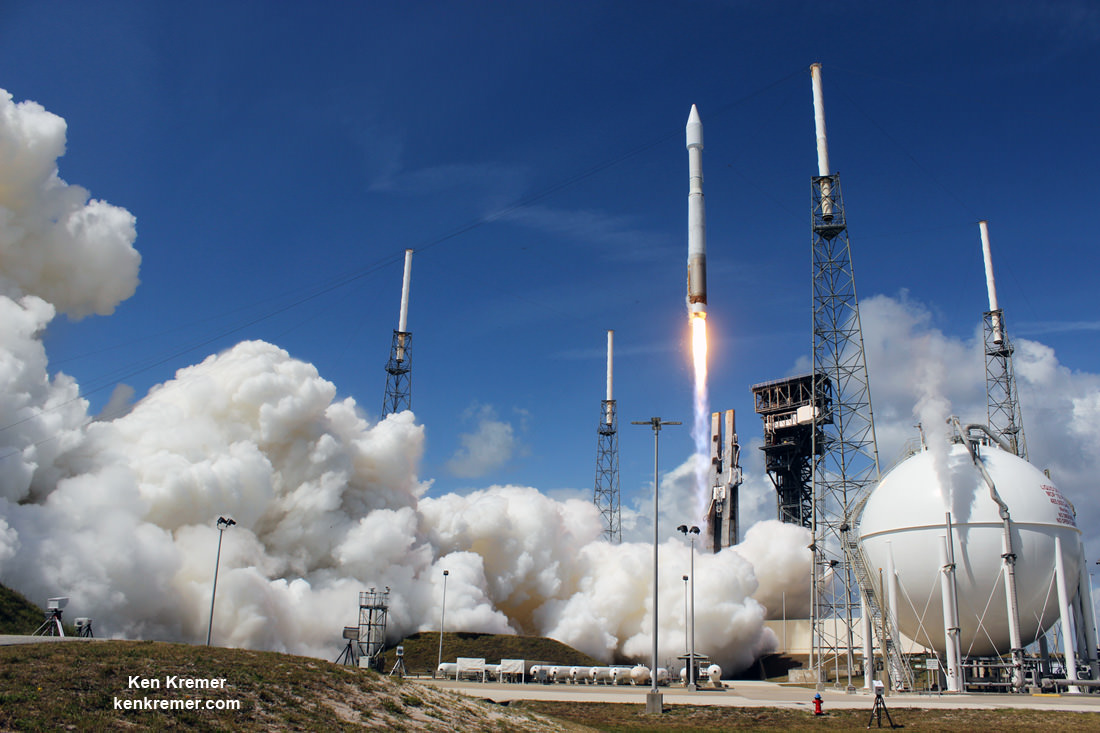
Four days after liftoff the SS John Glenn finally arrived at the station as planned Saturday morning April 22 following a carefully choreographed series of thruster maneuvers this past week.
The private Cygnus resupply vessel is carrying nearly four tons of science and supplies crammed inside for the five person multinational Expedition 51 crew.
After reaching the vicinity of the space station overnight Saturday, Cygnus was successfully captured by astronaut crew members Thomas Pesquet of ESA (European Space Agency) and Expedition 51 Station Commander Peggy Whitson of NASA at 6:05 a.m. EDT using the space station’s 57.7-foot (17.6-meter) Canadian-built Canadarm2 robotic arm.
The SS John Glenn Cygnus vehicle counts as Orbital ATK’s seventh cargo delivery flight to the station.
The vehicle is also known alternatively as the Cygnus OA-7 or CRS-7 mission.
Cygnus OA-7 is loaded with 3459 kg (7626 pounds) of science experiments and hardware, crew supplies, spare parts, gear and station hardware to the orbital laboratory in support over 250 research experiments being conducted on board by the Expedition 51 and 52 crews. The total volumetric capacity of Cygnus exceeds 27 cubic meters.
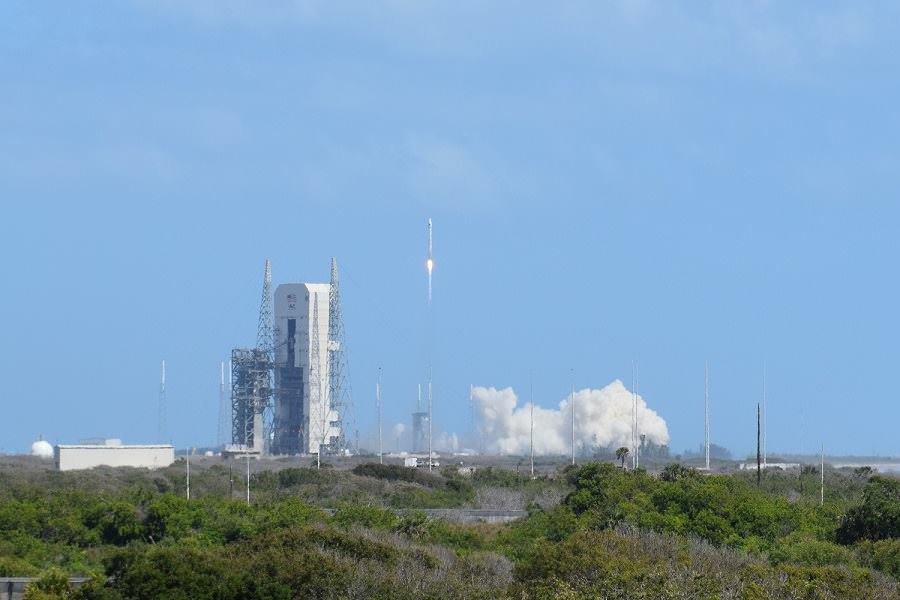
The Orbital ATK SS John Glenn Cygnus is the 2nd US cargo ship to launch to the ISS this year following the SpaceX Dragon CRS-10 mission in February – as I reported here.
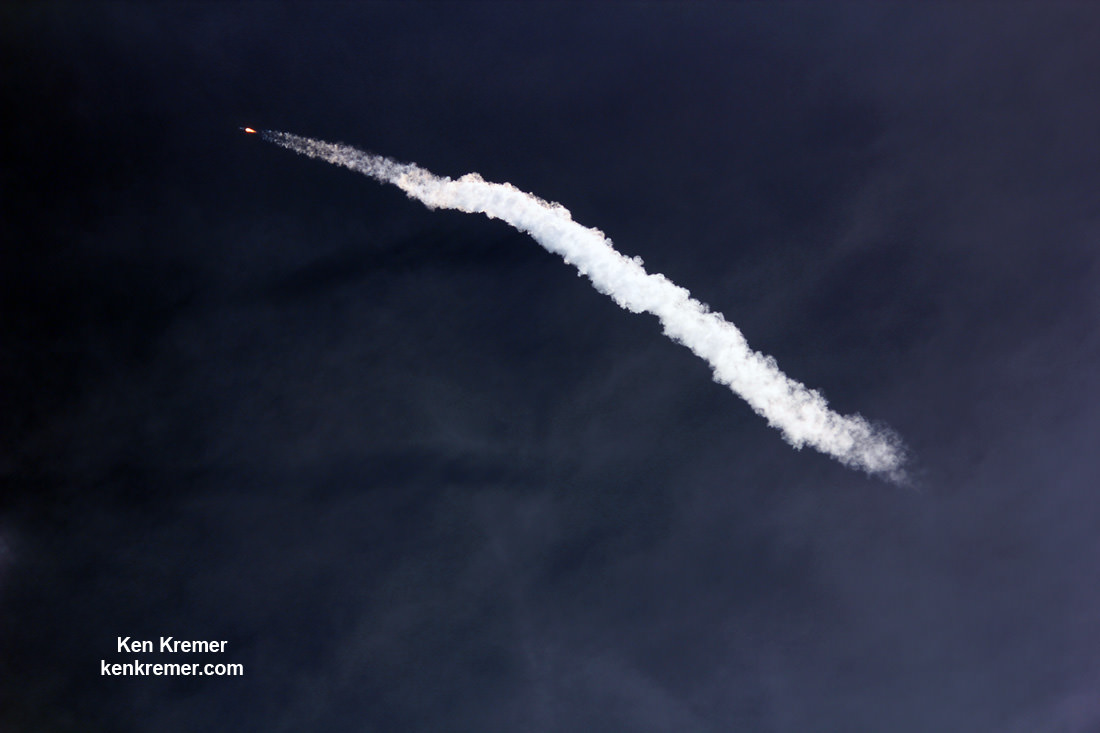
Watch for Ken’s continuing onsite launch reports direct from the Kennedy Space Center and Cape Canaveral Air Force Station in Florida.
Stay tuned here for Ken’s continuing Earth and Planetary science and human spaceflight news.
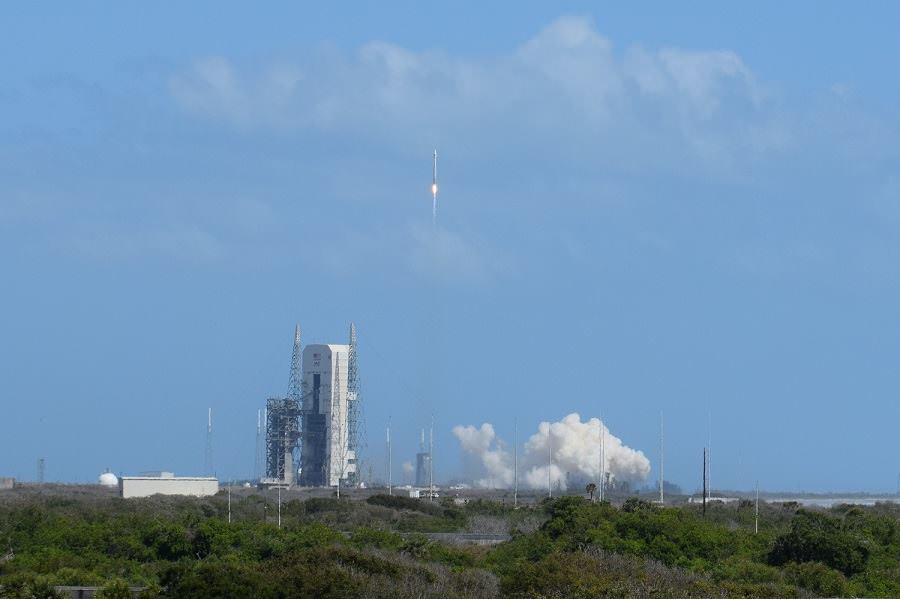
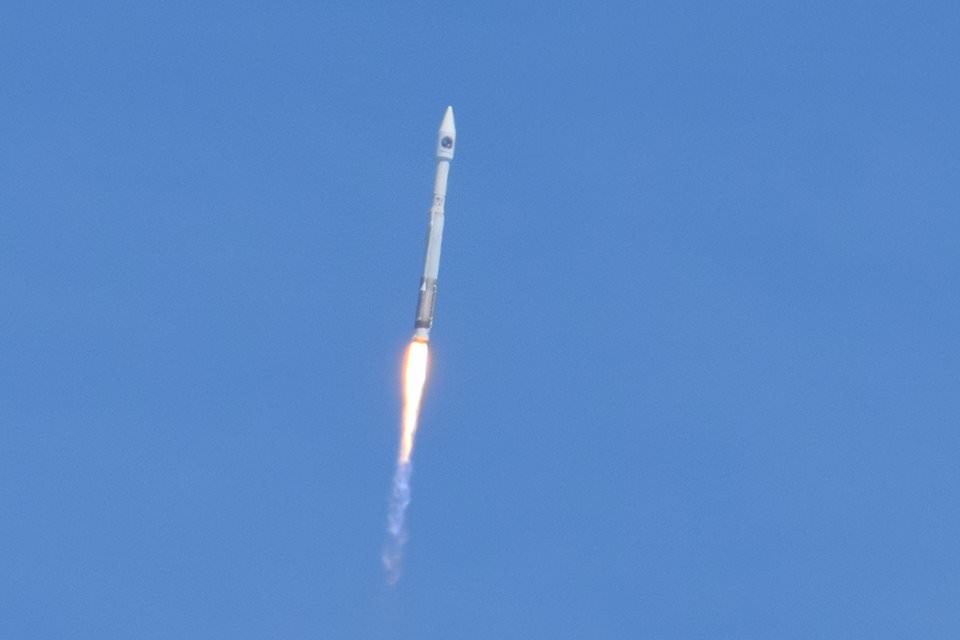

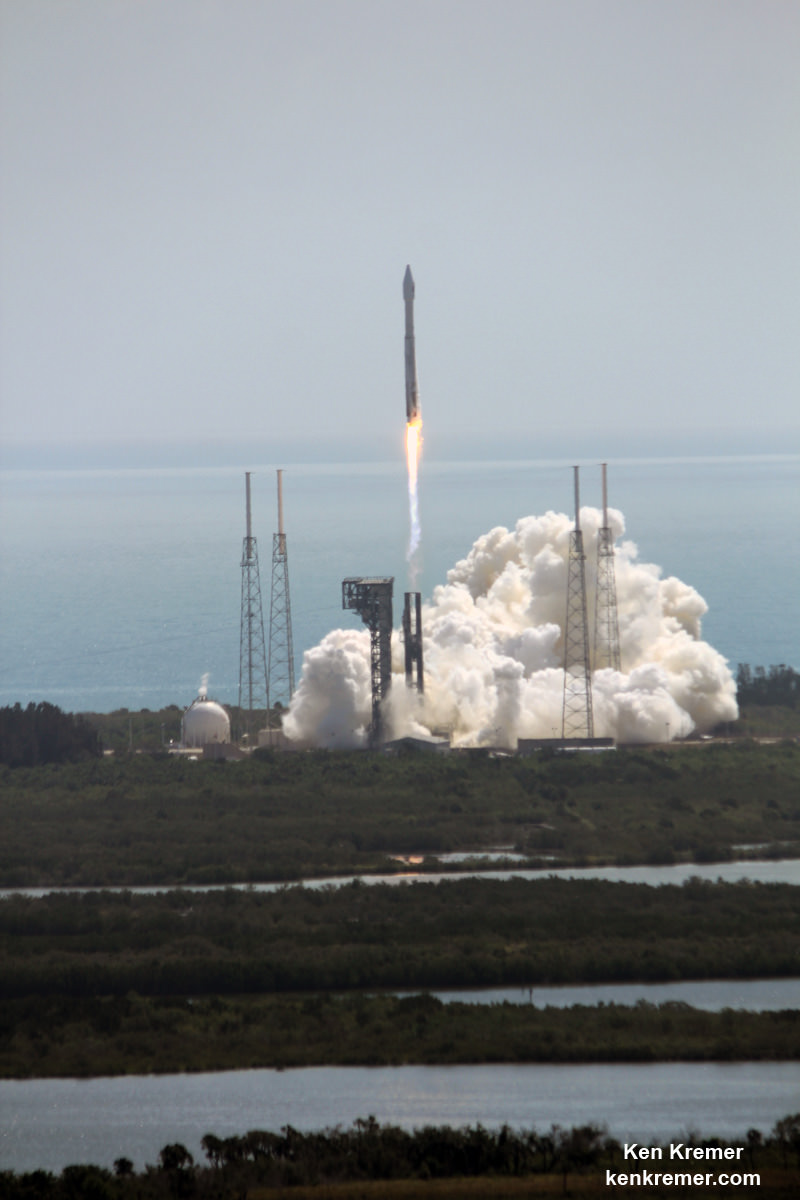

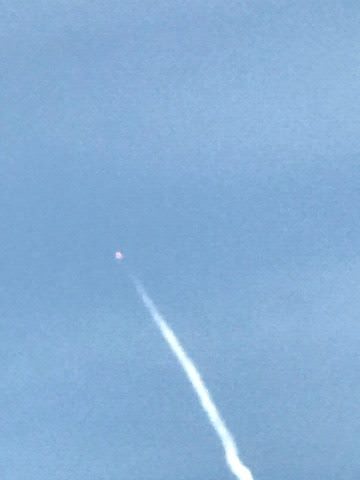
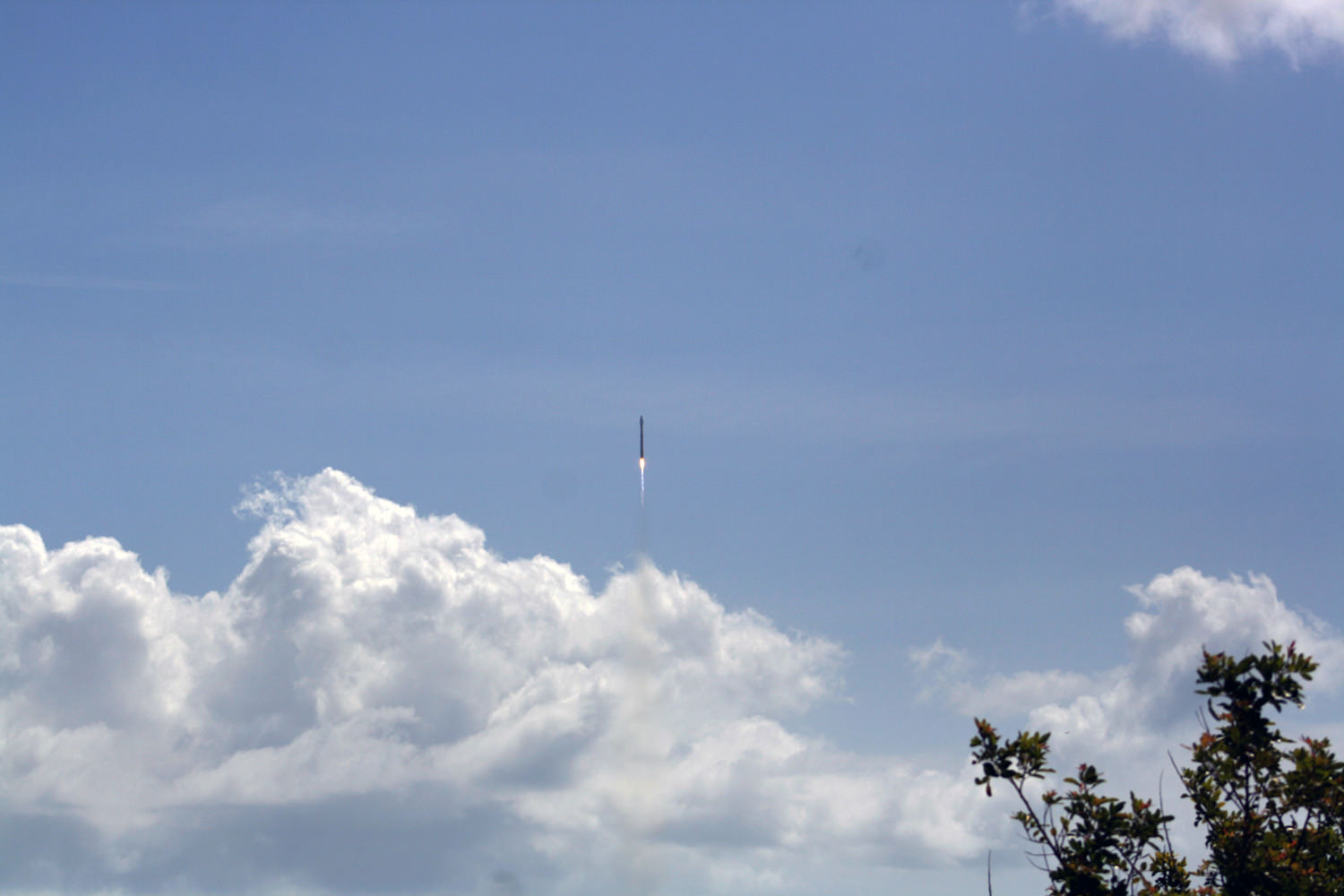
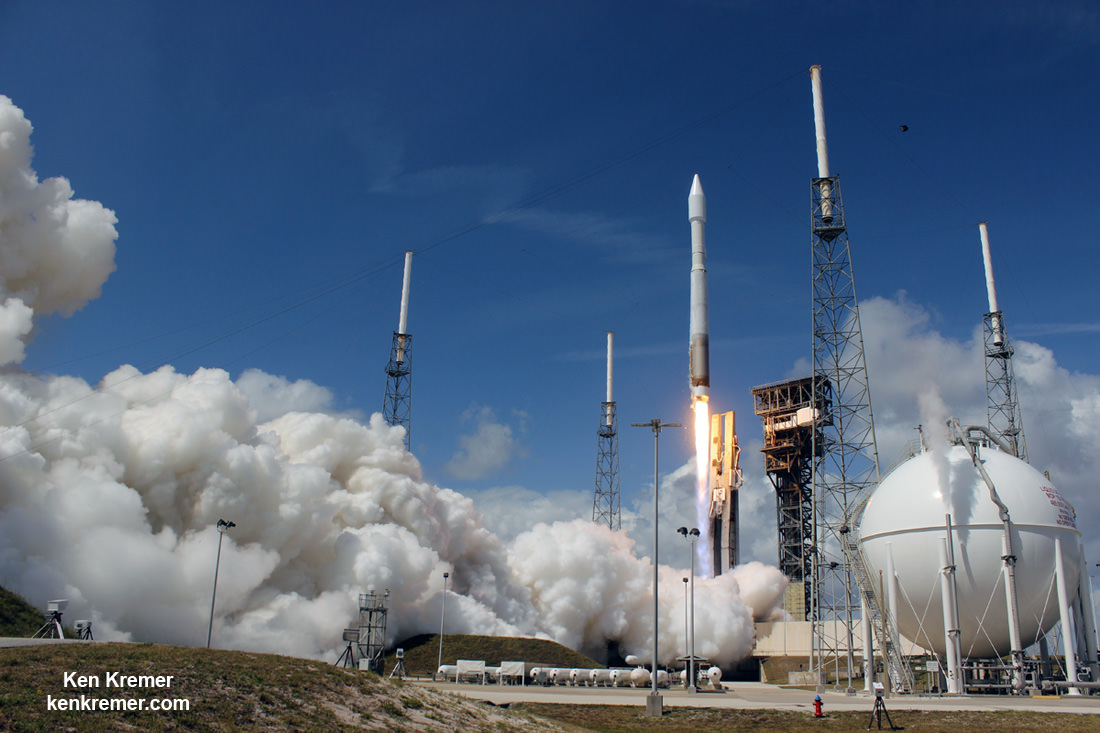
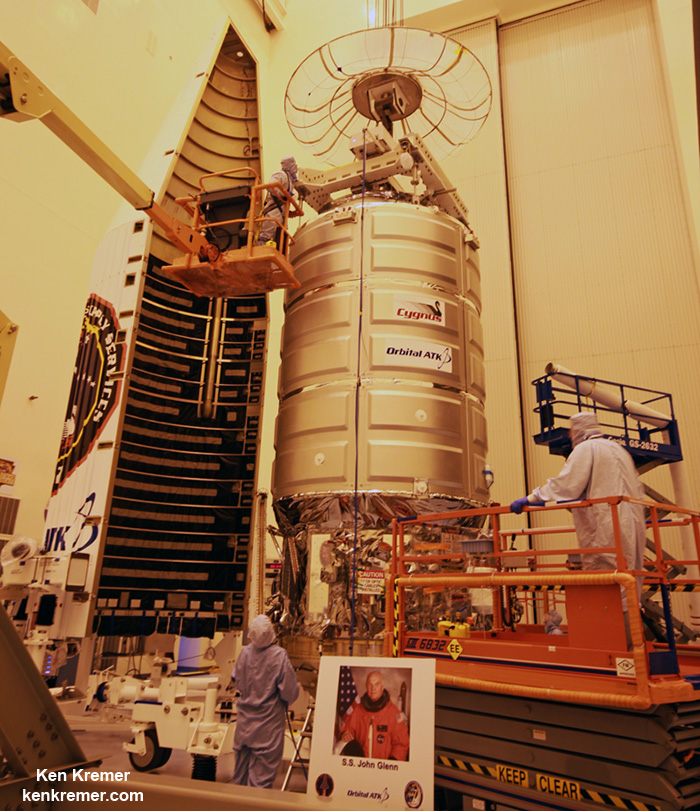
SS John Glenn to Debut as World’s 1st Live 360 Degree Video of Rocket Launch April 18
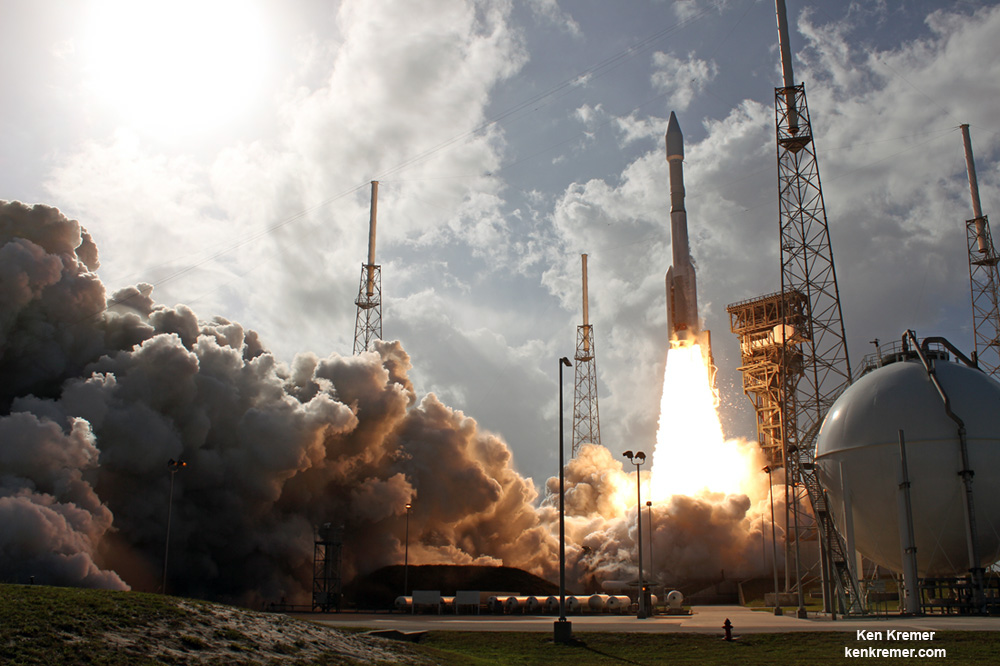

KENNEDY SPACE CENTER, FL – Imagine watching a real rocket launch in a 360 degree live video broadcast. Well NASA is about to make it happen for the first time in a big way and on a significant mission.
On Tuesday April 18, NASA will broadcast the launch of the ‘S.S. John Glenn’ space station cargo freighter in a feat marking the world’s first live 360-degree stream of a rocket launch – namely the United Launch Alliance (ULA) Atlas V rocket.
The ‘S.S. John Glenn’ is named in honor of legendary NASA astronaut John Glenn – the first American to orbit Earth back in February 1962.
The late morning daytime launch offers the perfect opportunity to debut this technology with the rocket magnificently visible atop a climbing plume of smoke and ash – and with a “pads-eye” view!
The ‘S.S. John Glenn’ is actually a Cygnus resupply spacecraft built by NASA commercial cargo provider Orbital ATK for a cargo mission heading to the International Space Station (ISS) – jam packed with nearly 4 tons or research experiments and gear for the stations Expedition 51 crew of astronauts and cosmonauts.
“NASA, in coordination with United Launch Alliance (ULA) and Orbital ATK, will broadcast the world’s first live 360-degree stream of a rocket launch,” the agency announced in a statement.
“The live 360 stream enables viewers to get a pads-eye view.”
The Cygnus spaceship will launch on a ULA Atlas V rocket from Space Launch Complex 41 at Cape Canaveral Air Force Station in Florida.
Liftoff of the S.S. John Glenn on Orbital ATK’s seventh commercial resupply services mission to the ISS – dubbed OA-7 or CRS-7 – is slated for 11:11 a.m. EDT Tuesday, April 18.
The launch window lasts 30 minutes and runs from 11;11-11:41 a.m. EDT.
You can watch the live 360 stream of the Atlas V/OA-7 cargo resupply mission liftoff to the ISS on the NASA Television YouTube channel starting 10 minutes prior to lift off at:
http://youtube.com/nasatelevision
The sunshine state’s weather outlook is currently very promising with a forecast of an 80% chance of favorable ‘GO’ conditions at launch time Tuesday morning.
John Glenn was selected as one of NASA’s original seven Mercury astronauts chosen at the dawn of the space age in 1959. He recently passed away on December 8, 2016 at age 95.

The S.S. John Glenn will carrying more than 7,600 pounds of science research, crew supplies and hardware to the orbiting outpost.
How can you watch the streaming 360 video? Read NASA’s description:
“To view in 360, use a mouse or move a personal device to look up and down, back and forth, for a 360-degree view around Space Launch Complex-41 at Cape Canaveral Air Force Station, Florida. Note: not all browsers support viewing 360 videos. YouTube supports playback of 360-degree videos on computers using Chrome, Firefox, Internet Explorer and Opera browsers. Viewers may use the YouTube app to view the launch on a smart phone. Those who own virtual reality headsets will be able to look around and experience the view as if they were actually standing on the launch pad.”
“While virtual reality and 360 technology have been increasing in popularity, live 360 technology is a brand new capability that has recently emerged. Recognizing the exciting possibilities opened by applying this new technology to spaceflight, NASA, ULA, and Orbital ATK seized this opportunity to virtually place the public at the base of the rocket during launch. Minimum viewing distance is typically miles away from the launch pad, but the live 360 stream enables viewers to get a pads-eye view.”
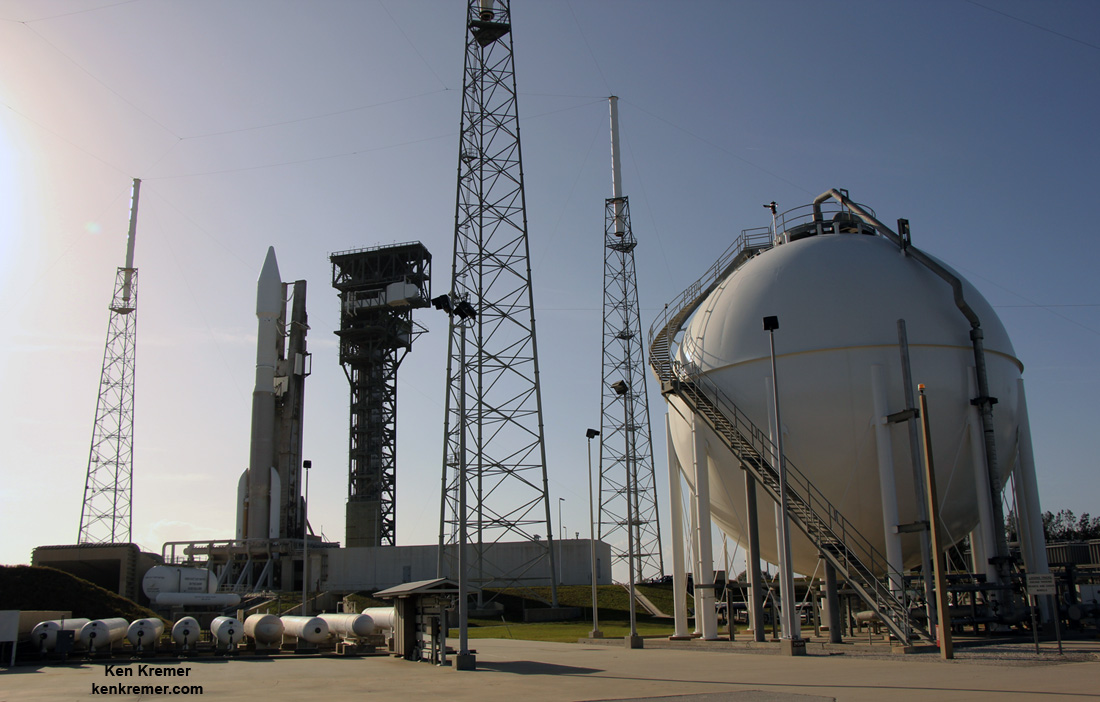
The naming announcement for the ‘S.S. John Glenn’ was made by spacecraft builder Orbital ATK during a ceremony held inside the Kennedy Space Center (KSC) clean room facility when the cargo freighter was in the final stages of flight processing – and attended by media including Universe Today on March 9.
“It is my humble duty and our great honor to name this spacecraft the S.S. John Glenn,” said Frank DeMauro, vice president and general manager of Orbital ATK’s Advanced Programs division, during the clean room ceremony inside the Payload Hazardous Servicing Facility (PHFS) high bay at NASA’s Kennedy Space Center in Florida.
Stay tuned here for Ken’s continuing Earth and Planetary science and human spaceflight news.
………….
Learn more about the SS John Glenn/ULA Atlas V launch to ISS, NASA missions and more at Ken’s upcoming outreach events at Kennedy Space Center Quality Inn, Titusville, FL:
Apr 17-19: “SS John Glenn/ULA Atlas V launch to ISS, SpaceX SES-10, EchoStar 23, CRS-10 launch to ISS, ULA Atlas SBIRS GEO 3 launch, GOES-R weather satellite launch, OSIRIS-Rex, SpaceX and Orbital ATK missions to the ISS, Juno at Jupiter, ULA Delta 4 Heavy spy satellite, SLS, Orion, Commercial crew, Curiosity explores Mars, Pluto and more,” Kennedy Space Center Quality Inn, Titusville, FL, evenings
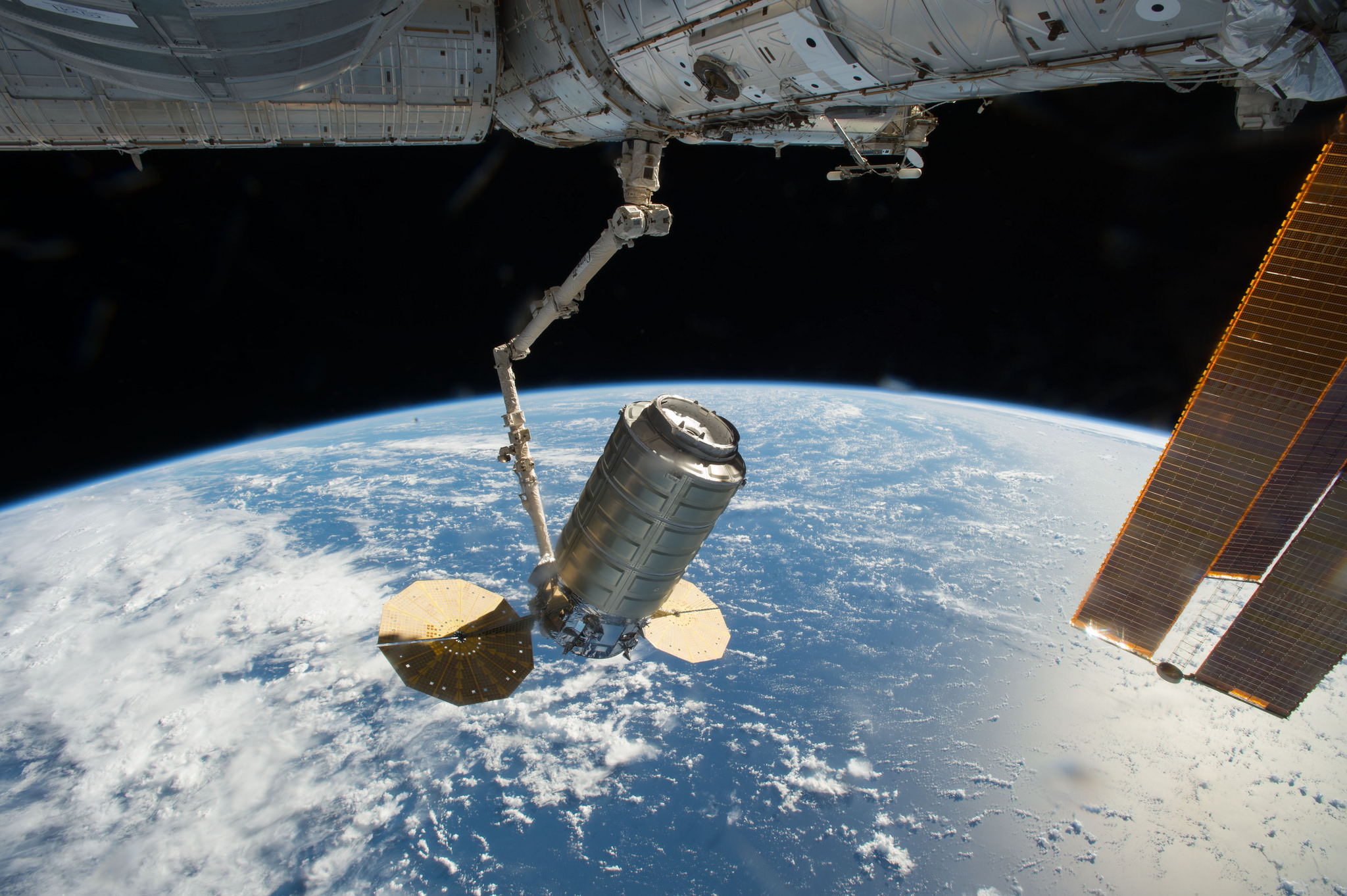
March Launch Madness: Triple Headed Space Spectacular Starts Overnight with SpaceX March 14 – Watch Live
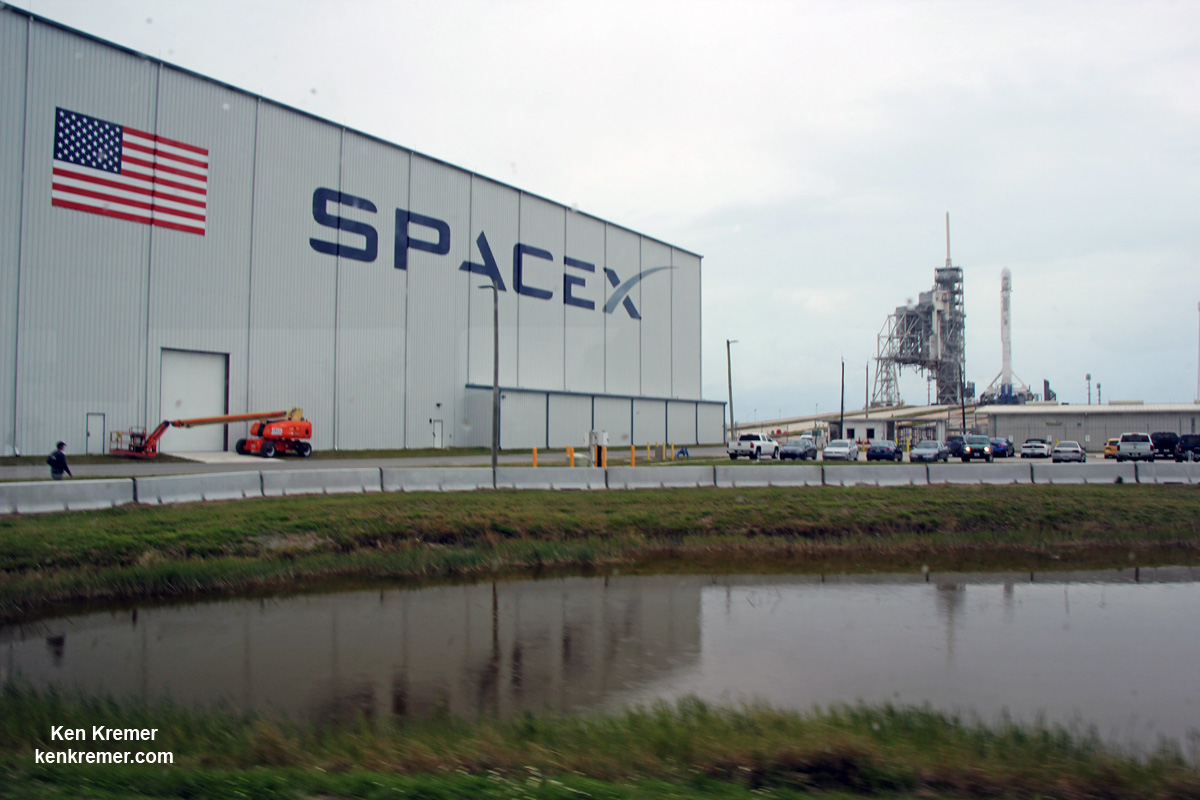

KENNEDY SPACE CENTER, FL – It’s March Madness for Space fans worldwide! A triple header of space spectaculars starts overnight with a SpaceX Falcon 9 launching in the wee hours of Tuesday, March 14 from the Florida Space Coast.
Indeed a trio of launches is planned in the next week as launch competitor and arch rival United Launch Alliance (ULA) plans a duo of nighttime blastoffs from their Delta and Atlas rocket families – following closely on the heels of the SpaceX Falcon 9 launching a commercial telecommunications satellite.
Of course it’s all dependent on everything happening like clockwork!
And there is no guarantee of that given the unpredictable nature of the fast changing weather on the Florida Space Coast and unknown encounters with technical gremlins which have already plagued all 3 rockets this month.
Each liftoff has already been postponed by several days this month. And the rocket launch order has swapped positions.
At any rate, SpaceX is now the first on tap after midnight tonight on Tuesday, March 14.
The Delta IV and Atlas V will follow on March 17 and March 21 respectively – if all goes well.
So to paraphrase moon walker Buzz Aldrin;
‘Get Your Ass to the Florida Space Coast – Fast !’
The potential for a grand slam also exists at the very end of the month. But let’s get through at least the first launch of Falcon first.
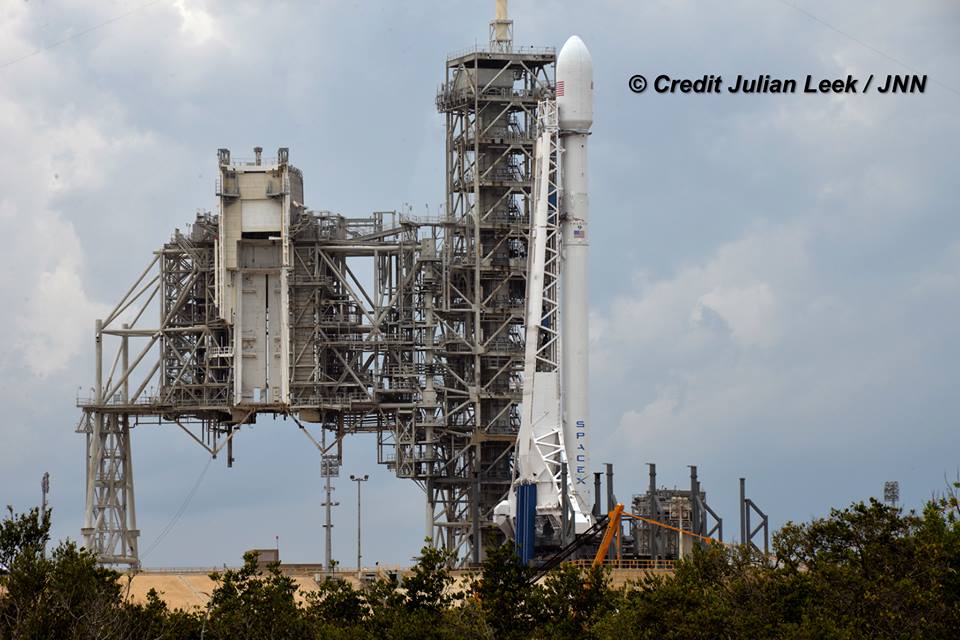
Liftoff of the two stage SpaceX Falcon 9 carrying the EchoStar 23 telecommunications satellite is now slated for a post midnight spectacle next Tuesday, Mar. 14 from launch pad 39A on the Kennedy Space Center at the opening of the launch window at 1:34 a.m. EDT.
The two and a half hour launch window closes at 4:04 a.m. EDT.
You can watch the launch live on a SpaceX dedicated webcast starting about 20 minutes prior to the 1:34 a.m. liftoff time.
The SpaceX webcast will be available starting at about 20 minutes before liftoff, at approximately 1:14 a.m. EDT.
Watch at: SpaceX.com/webcast
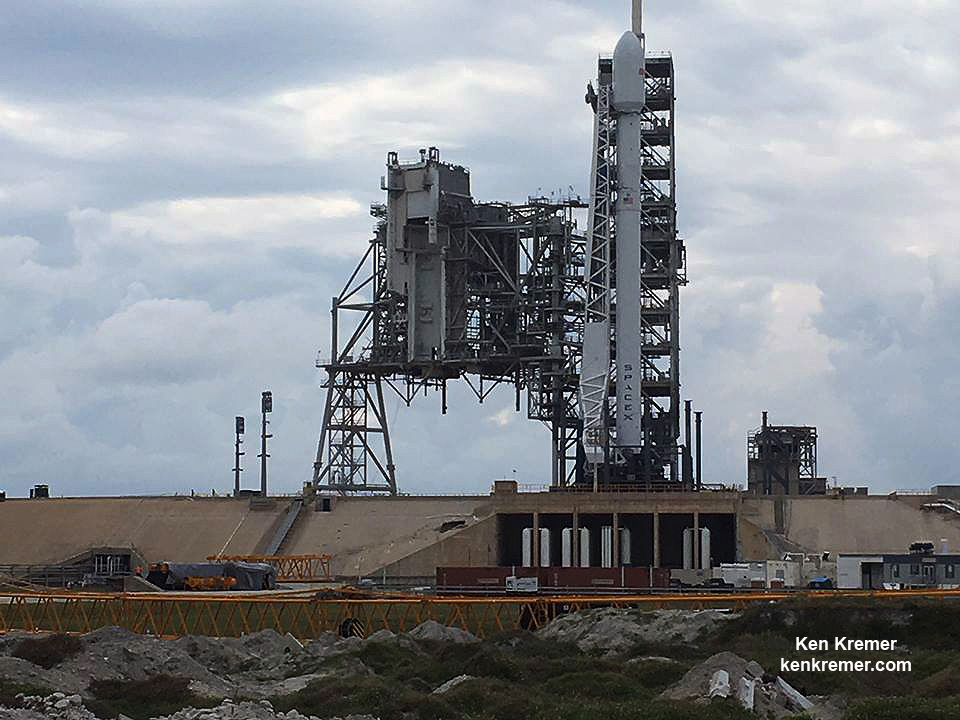
Following a successful static fire test last week on Mar. 9 of the first stage boosters engines, the SpaceX Falcon 9 was integrated with the EchoStar 23 direct to home TV satellite and rolled back out to pad 39A
The Falcon 9 rocket was raised erect into launch position by the time I visited the pad this afternoon, Monday March 13, to set up my cameras.
The weather outlook is not great at this moment, with rain and thick clouds smothering the coastline and central Florida.
The planned Mar. 14 launch comes barely three weeks after the Falcon’s successful debut on Feb. 19 on the NASA contracted Dragon CRS-10 mission that delivered over 2.5 tons of cargo to the six person crew living and working aboard the International Space Station (ISS).
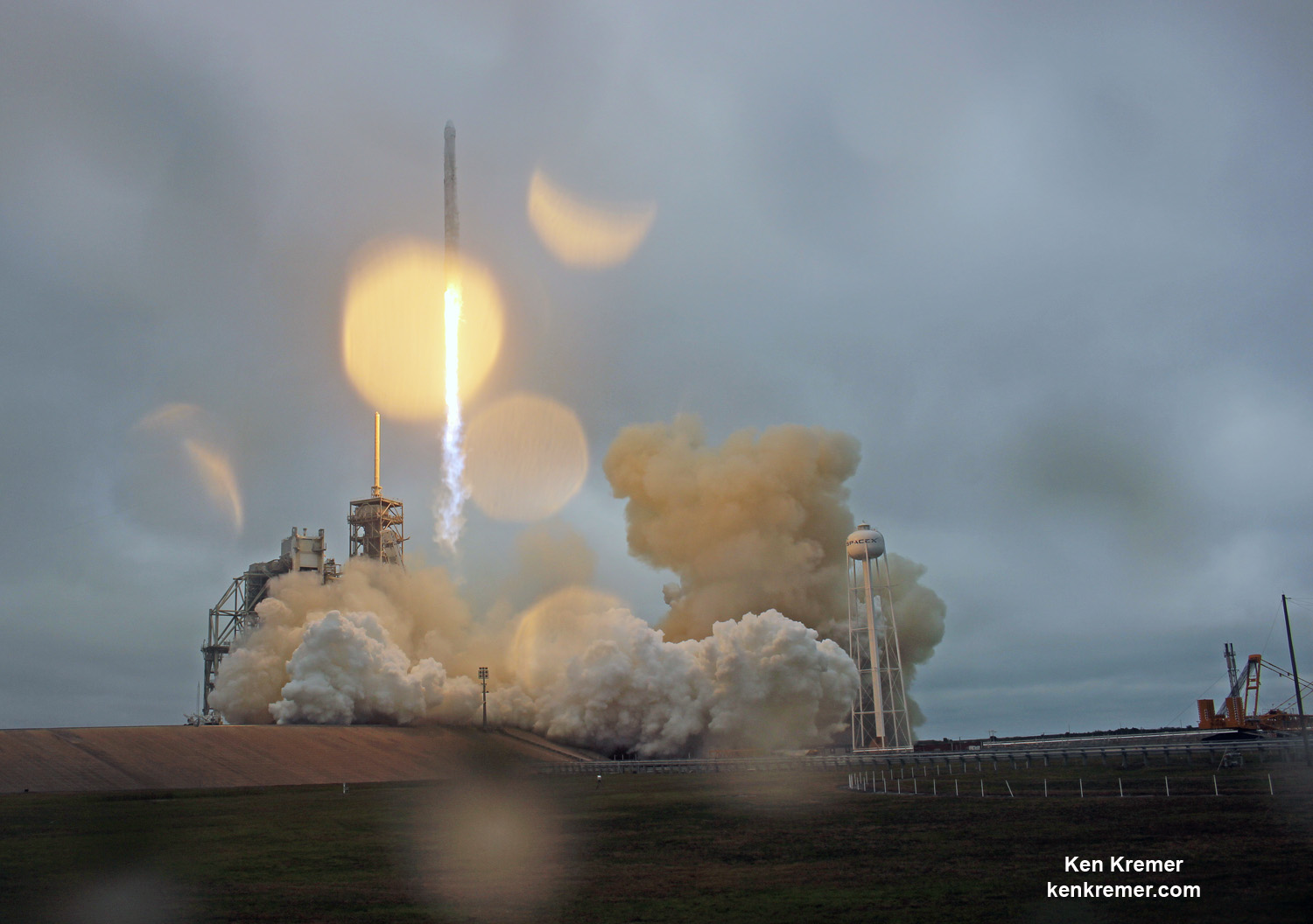
Launch Complex 39A was repurposed by SpaceX from launching Shuttles to Falcons. It had lain dormant for launches for nearly six years since Space Shuttle Atlantis launched on the final shuttle mission STS 135 in July 2011.
SpaceX bilionaire CEO Elon Musk announced last week that he wants to launch a manned Moonshot from pad 39A by the end of next year using his triple barreled Falcon Heavy heavy lift rocket – derived from the Falcon 9.
The second launch of the trio on tap is a United Launch Alliance Delta 4 rocket carrying the WGS-9 high speed military communications satellite for the U.S. Air Force.
Liftoff of the ULA Delta is slated for March 17 from Space Launch Complex-37 at 7: 44 p.m. EDT.
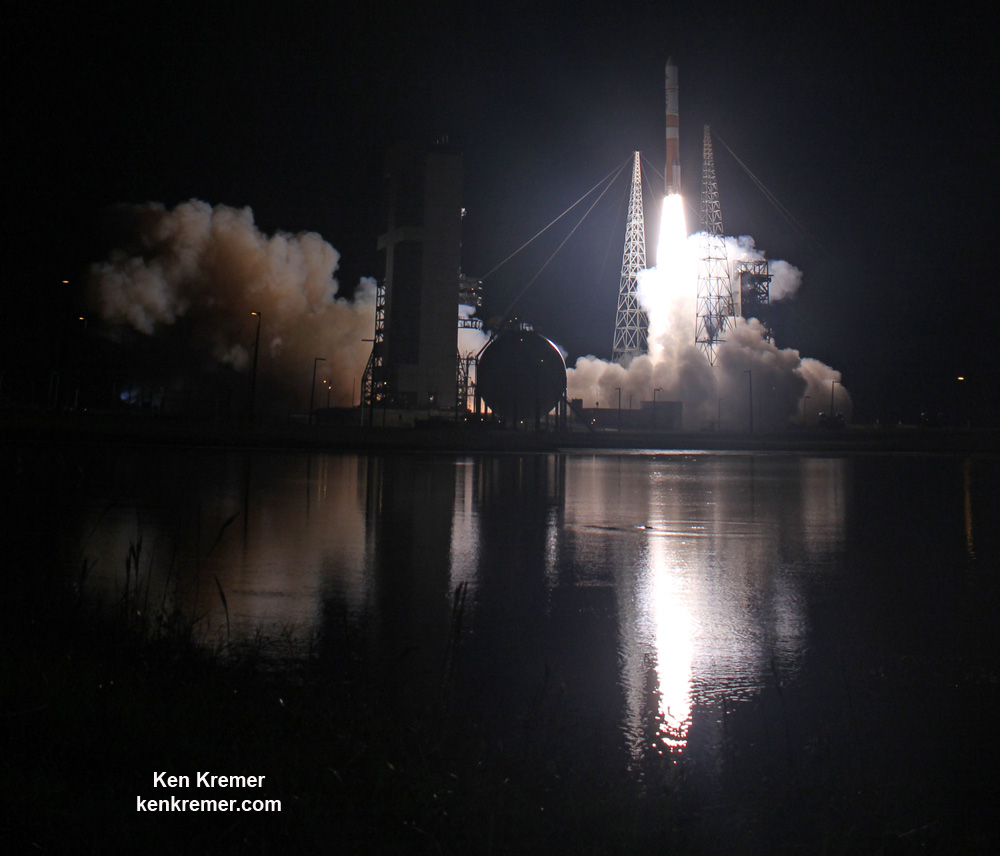
The S.S. John Glenn is scheduled to as the Orbital ATK Cygnus OA-7 spacecraft for NASA on a United Launch Alliance (ULA) Atlas V rocket launch no earlier than March 21 from Space launch Complex-41 (SLC-41) on Cape Canaveral Air Force Station, Florida.

Stay tuned here for Ken’s continuing Earth and Planetary science and human spaceflight news.
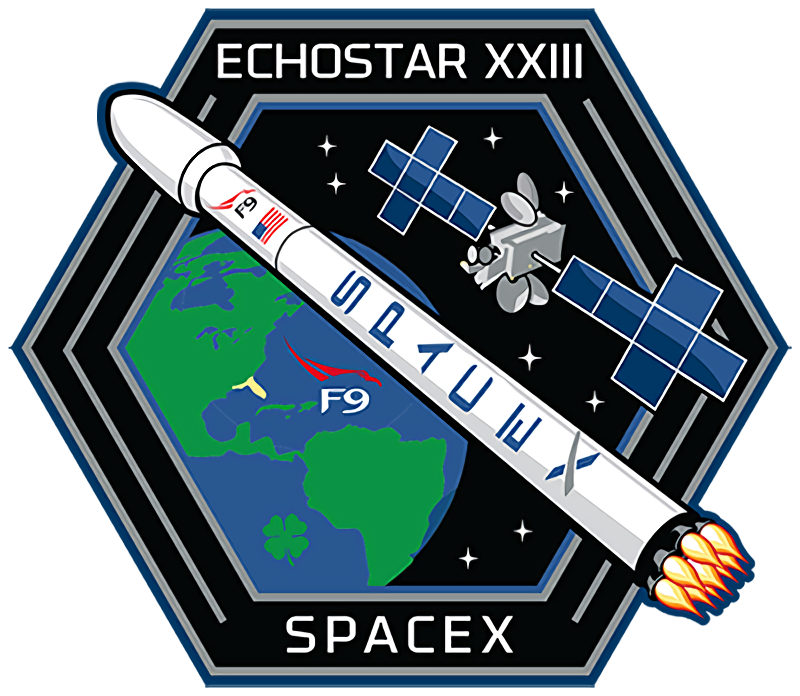
………….
Learn more about SpaceX EchoStar 23 and CRS-10 launch to ISS, ULA SBIRS GEO 3 launch, EchoStar launch GOES-R launch, Heroes and Legends at KSCVC, OSIRIS-REx, InSight Mars lander, ULA, SpaceX and Orbital ATK missions, Juno at Jupiter, SpaceX AMOS-6, ISS, ULA Atlas and Delta rockets, Orbital ATK Cygnus, Boeing, Space Taxis, Mars rovers, Orion, SLS, Antares, NASA missions and more at Ken’s upcoming outreach events at Kennedy Space Center Quality Inn, Titusville, FL:
Mar 13-15: “SpaceX EchoStar 23, CRS-10 launch to ISS, ULA Atlas SBIRS GEO 3 launch, EchoStar 19 comsat launch, GOES-R weather satellite launch, OSIRIS-Rex, SpaceX and Orbital ATK missions to the ISS, Juno at Jupiter, ULA Delta 4 Heavy spy satellite, SLS, Orion, Commercial crew, Curiosity explores Mars, Pluto and more,” Kennedy Space Center Quality Inn, Titusville, FL, evenings
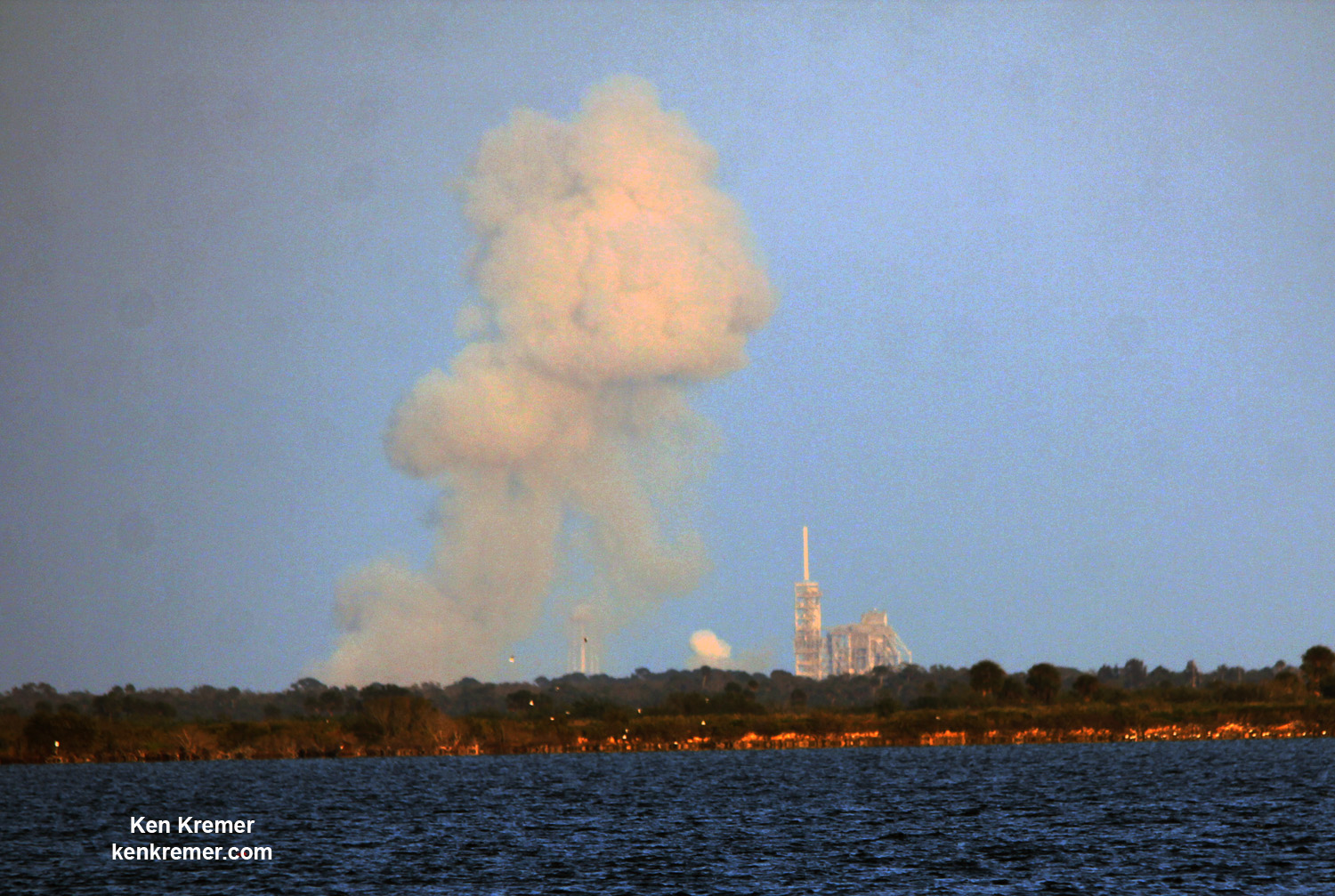
New Age in Weather Forecasting Begins with Spectacular 1st Images from NASA/NOAA GOES-16 Observatory


KENNEDY SPACE CENTER, FL – A new age has begun in the nations weather forecasting capabilities with the release today (Jan. 23) of the spectacular first images gathered by the recently launched NASA/NOAA GOES-16 observatory.
The highly advanced Geostationary Operational Environmental Satellite-16 (GOES-16) weather observatory lifted off two months ago atop a ULA Atlas V rocket on Nov. 19, 2016 from Space Launch Complex 41 (SLC-41) on Cape Canaveral Air Force Station, Florida.
GOES-16 (formerly known as GOES-R through the launch) is the first in a new series of revolutionary NASA/NOAA geostationary weather satellites that entails the first significant instrument upgrade to US weather forecasting capabilities in more than two decades.
“It will be like high-definition from the heavens,” says NOAA.
“Today’s release of the first images from #GOES16 signals the start of a new age in satellite weather observation!!!”
Thus the newly obtained and published imagery has been anxiously awaited by scientists, meteorologists and ordinary weather enthusiasts.
“This is such an exciting day for NOAA! One of our GOES-16 scientists compared this to seeing a newborn baby’s first pictures — it’s that exciting for us,” said Stephen Volz Ph.D. director of NOAA’s Satellite and Information Service, in a statement.
“These images come from the most sophisticated technology ever flown in space to predict severe weather on Earth. The fantastically rich images provide us with our first glimpse of the impact GOES-16 will have on developing life-saving forecasts.”

An especially eye-popping image taken by GOES -16 from its equatorial vantage point situated in geostationary orbit 22,300 miles (35,800 kilometers) above Earth and published today, shows both the Earth and the Moon together – as the lead image here.
The Earth/Moon combo shot is not only fantastically pleasing to the eye, but also serves a significant scientific purpose.
“Like earlier GOES satellites, GOES-16 will use the moon for calibration,” say NOAA officials.
“GOES-16 will boost the nation’s weather observation network and NOAA’s prediction capabilities, leading to more accurate and timely forecasts, watches and warnings.”
GOES-16 is the most advanced and powerful weather observatory ever built and will bring about a ‘quantum leap’ in weather forecasting.
“Seeing these first images from GOES-16 is a foundational moment for the team of scientists and engineers who worked to bring the satellite to launch and are now poised to explore new weather forecasting possibilities with this data and imagery,” said Volz.
“The incredibly sharp images are everything we hoped for based on our tests before launch. We look forward to exploiting these new images, along with our partners in the meteorology community, to make the most of this fantastic new satellite.”
It’s dramatic new imagery will show the weather in real time enabling critical life and property forecasting, help pinpoint evacuation zones and also save people’s lives in impacted areas of severe weather including hurricanes and tornadoes.
And the huge satellite can’t come online soon enough, as demonstrated by the severe winter weather and tornadoes that just wreaked havoc and death in various regions of the US.
Another breathtaking image product (seen below) produced by the GOES-16 Advanced Baseline Imager (ABI) instrument, built by Harris Corporation, shows a full-disc view of the Western Hemisphere in high detail — at four times the image resolution of existing GOES spacecraft.
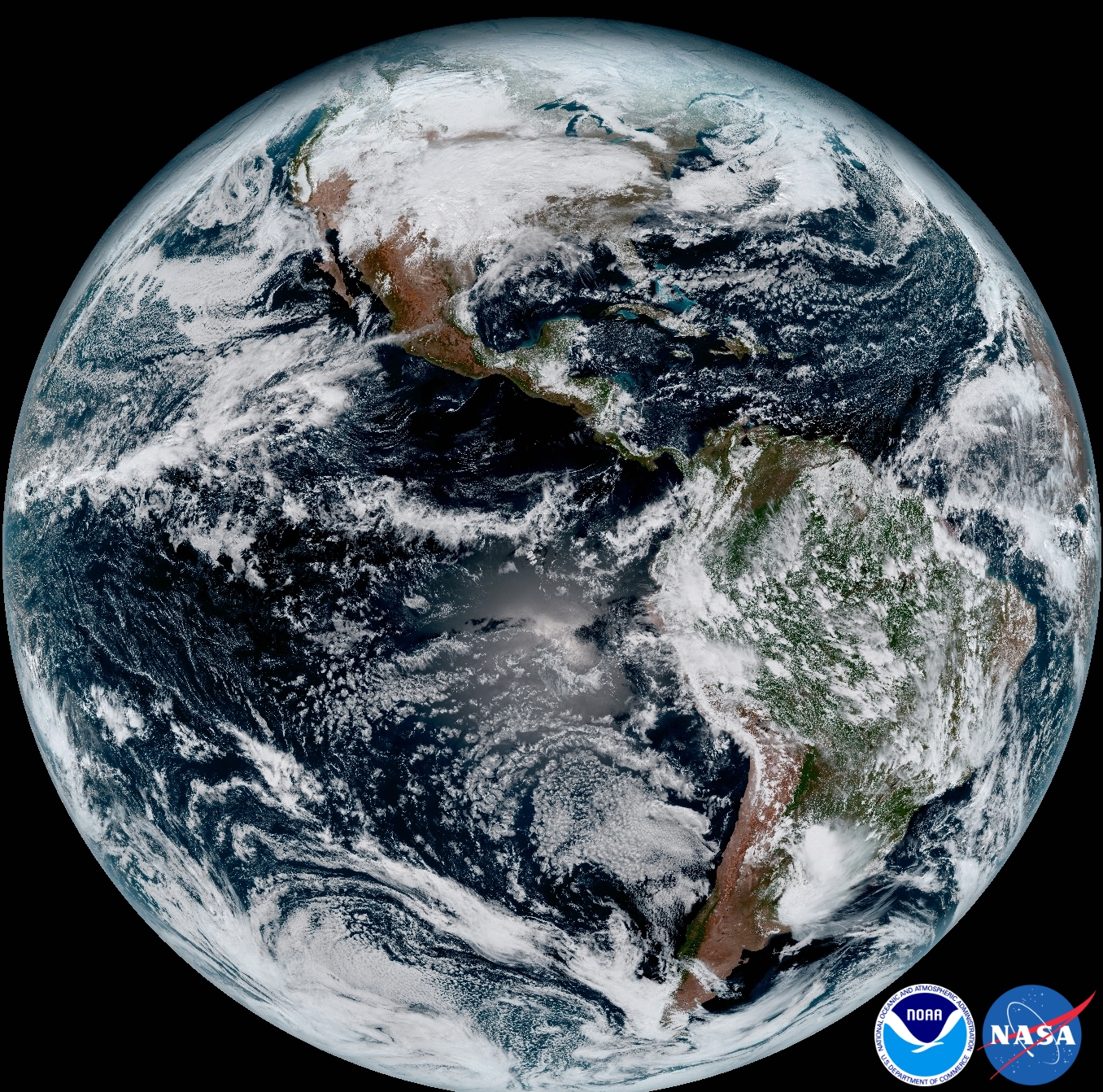
The 11,000 pound satellite was built by prime contractor Lockheed Martin and is the first of a quartet of four identical satellites – comprising GOES-R, S, T, and U – at an overall cost of about $11 Billion. This will keep the GOES satellite system operational through 2036.
This next generation of GOES satellites will replace the currently operating GOES East and GOES West satellites.
NOAA will soon decide whether GOES-16 will replace either the East or West satellites. A decision from NOAA is expected in May. GOES-16 will be operational by November 2017 as either the GOES-East or GOES-West satellite. Of course everyone wants it first.
The next satellite is nearing assembly completion and will undergo about a year of rigorous environmental and acoustic testing before launch. It will go to whichever slot was not selected this year.

The six instrument science suite includes the Advanced Baseline Imager (ABI) built by Harris Corporation, the Geostationary Lightning Mapper (GLM) built by Lockheed Martin, Solar Ultraviolet Imager (SUVI), Extreme Ultraviolet and X-Ray Irradiance Sensors (EXIS), Space Environment In-Situ Suite (SEISS), and the Magnetometer (MAG).
ABI is the primary instrument and will collect 3 times more spectral data with 4 times greater resolution and scans 5 times faster than ever before – via the primary Advanced Baseline Imager (ABI) instrument – compared to the current GOES satellites.

“The higher resolution will allow forecasters to pinpoint the location of severe weather with greater accuracy. GOES-16 can provide a full image of Earth every 15 minutes and one of the continental U.S. every five minutes, and scans the Earth at five times the speed of NOAA’s current GOES imagers.”
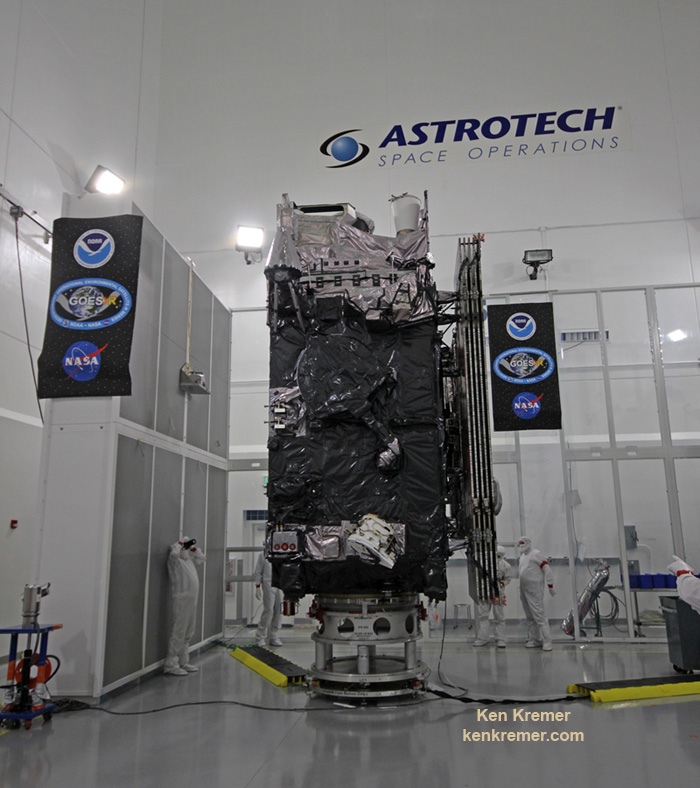
GOES-R launched on the massively powerful Atlas V 541 configuration vehicle, augmented by four solid rocket boosters on the first stage. As I witnessed and reported here.
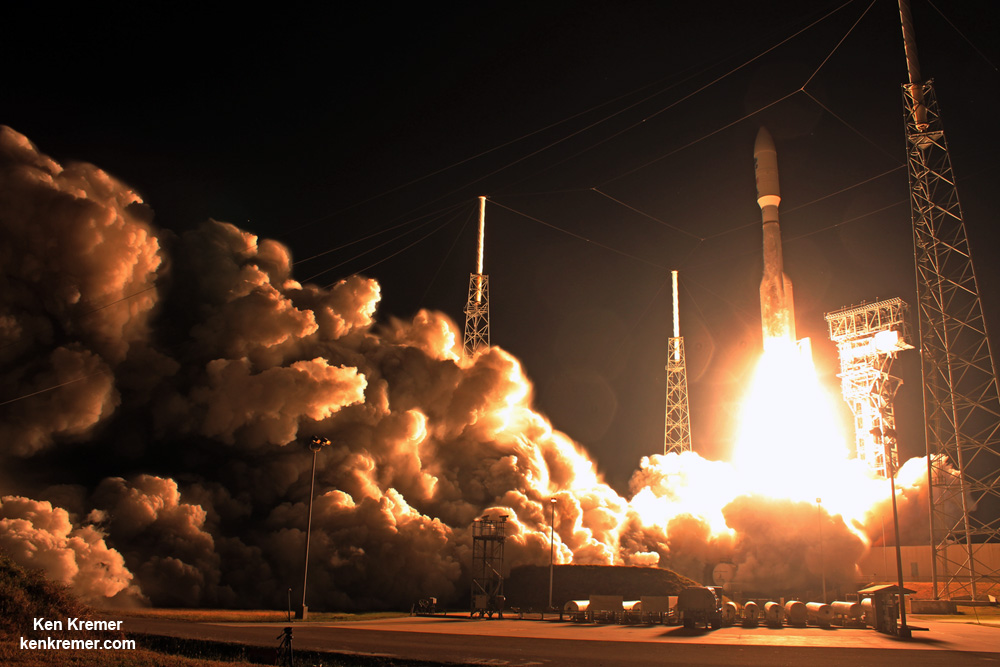
Stay tuned here for Ken’s continuing Earth and Planetary science and human spaceflight news.
Ken Kremer

USAF Missile Defense SBIRS Observatory Streaks to Orbit during Spectacular Evening Blastoff
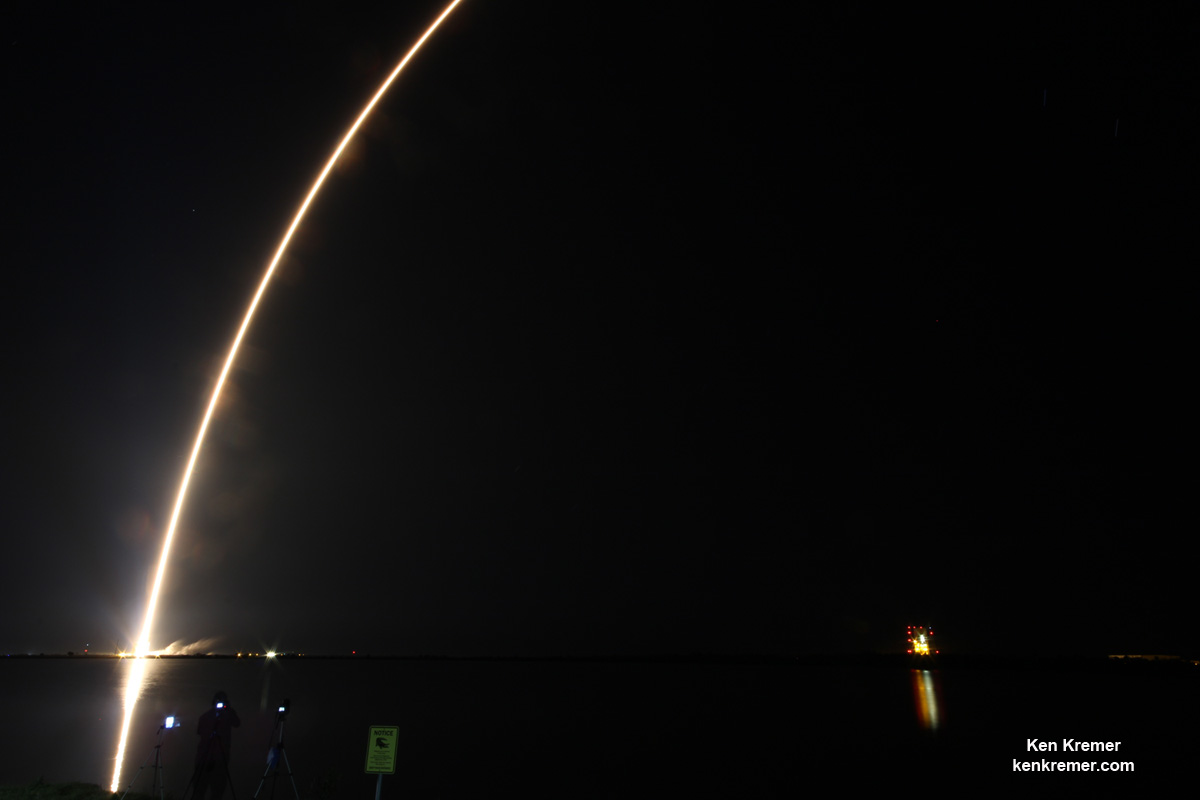

CAPE CANAVERAL AIR FORCE STATION, FL – A U.S. Air Force missile defense reconnaissance observatory that will track the telltale infrared signatures of incoming enemy missiles and is vital to America’s national security blasted off in spectacular fashion this evening, Jan. 20, 2017, as it streaked to orbit from the Florida Space Coast.
The United Launch Alliance Atlas V rocket carrying the $1.2 Billion Space Based Infrared System (SBIRS) GEO Flight 3 infrared imaging satellite lifted off at 7:42 p.m. ET from Space Launch Complex-41 on Cape Canaveral Air Force Station, Fla. – marking the first US east coast launch of 2017.
The SBIRS GEO Flight 3 was launched to geosynchronous transfer orbit to an altitude approx 22,000 miles (36,000 kilometers) above Earth.
The Atlas V was launched southeast at an inclination of 23.29 degrees. SBIRS GEO Flight 3 separated from the 2nd stage as planned 43 minutes after liftoff.
It is also the first of at least eleven launches of Atlas and Delta rockets by the aerospace firm this year.
The on time launch took place at the opening of the 40 minute launch window and after a 24 hour delay – when the launch was scrubbed yesterday (Jan. 19) after an aircraft flew into the Cape’s restricted airspace and could not be diverted in time before the launch window closed.
ULA also had to address sensor issues with the Atlas rockets RD-180 main engine during Thursday’s countdown.
Due to the scrub, the Atlas liftoff counts as the first launch of the Trump Administration rather the last of the Obama Administration.
With the unpredictable North Korean dictator Kim John Un threatening to launch an upgraded long range intercontinental ballistic missile this year that could potentially strike the United States west coast, SBIRS GEO 3 is more important than ever for our national defense.
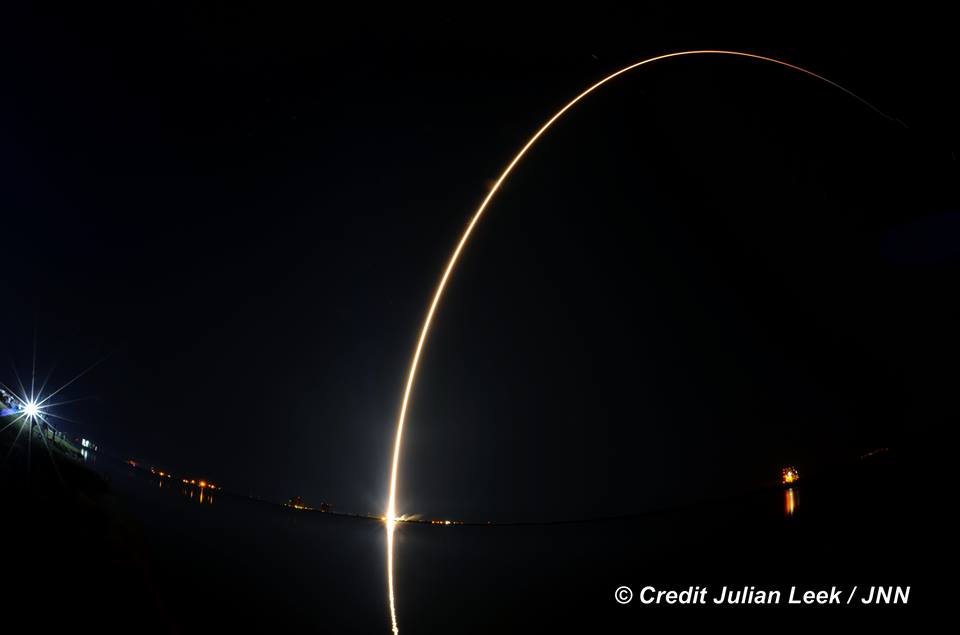
The SBIRS GEO Flight 3 is considered to be one of the highest priority military space programs in defense of the homeland.
The Space Based Infrared System is designed to provide global, persistent, infrared surveillance capabilities to meet 21st century demands in four national security mission areas: missile warning, missile defense, technical intelligence and battlespace awareness.
SBIRS will supplement and replace the legacy Defense Support Program (DSP) satellites currently in orbit and features vastly increased early missile detection and warning capabilities.
“ULA is proud to deliver this critical satellite which will improve surveillance capabilities for our national decision makers,” said Laura Maginnis, ULA vice president of Government Satellite Launch, in a statement.
“I can’t think of a better way to kick off the new year.”
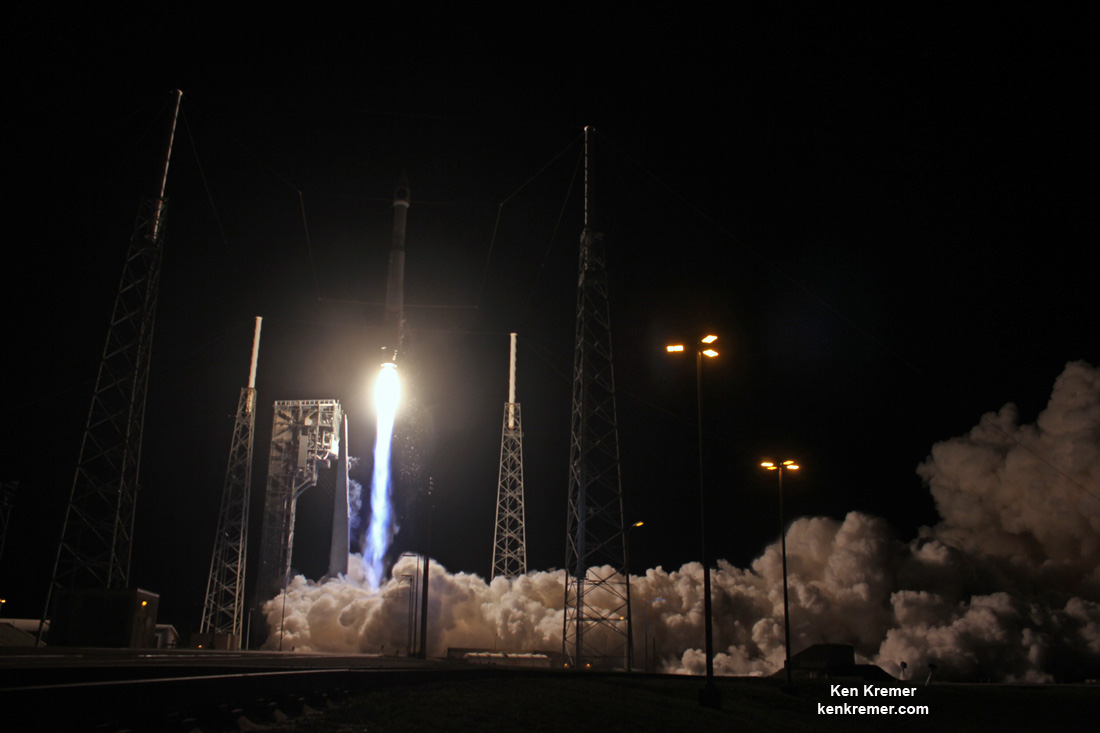
ULA is a joint venture of Boeing and Lockheed Martin with 116 successful launches under its belt after today’s liftoff.
The 194-foot-tall commercial Atlas V booster launched in the 401 rocket configuration with approximately 860,000 pounds of sea level first stage thrust powered by the dual nozzle Russian-built RD AMROSS RD-180 engine. There are no thrust augmenting solids attached to the first stage.
The satellite is housed inside a 4-meter diameter large payload fairing (LPF). The Centaur upper stage is powered by the Aerojet Rocketdyne RL10C engine.
Watch this video showing the detailed mission profile:
Video Caption: An Atlas V 401 configuration rocket will deliver the Air Force’s third Space-Based Infrared System (SBIRS) satellite to orbit. SBIRS, considered one of the nation’s highest priority space programs, is designed to provide global, persistent, infrared surveillance capabilities to meet 21st century demands. Credit: ULA
This mission marks the 34th Atlas V mission in the 401 configuration.
“The Atlas V 401 configuration has become the workhorse of the Atlas V fleet, delivering half of all Atlas V missions to date” said Maginnis.
“ULA understands that even with the most reliable launch vehicles, our sustained mission success is only made possible with seamless integration between our customer and our world class ULA team.”
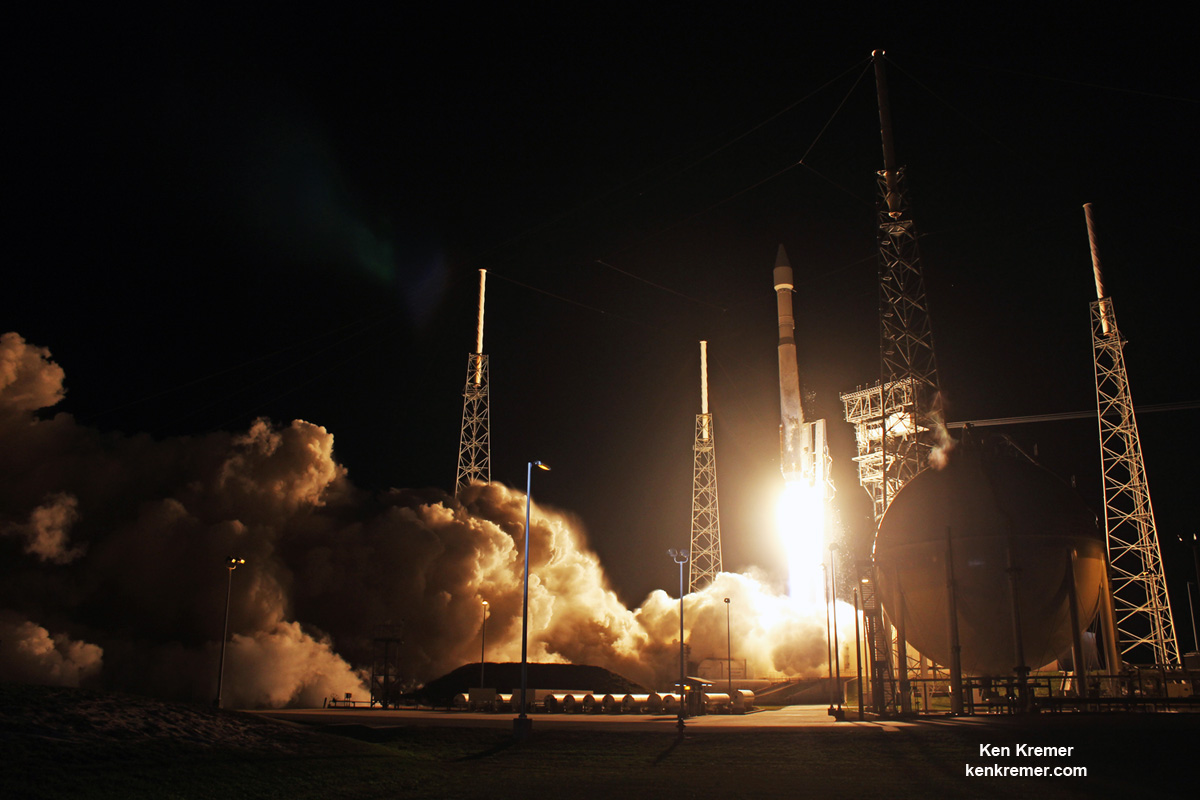
The two prior SBIRS GEO missions also launched on the ULA Atlas V 401 rocket.
The SBIRS team is led by the Remote Sensing Systems Directorate at the U.S. Air Force Space and Missile Systems Center. Lockheed Martin is the prime contractor, with Northrop Grumman as the payload integrator. Air Force Space Command operates the SBIRS system, according to a ULA description.
Stay tuned here for Ken’s continuing Earth and Planetary science and human spaceflight news.
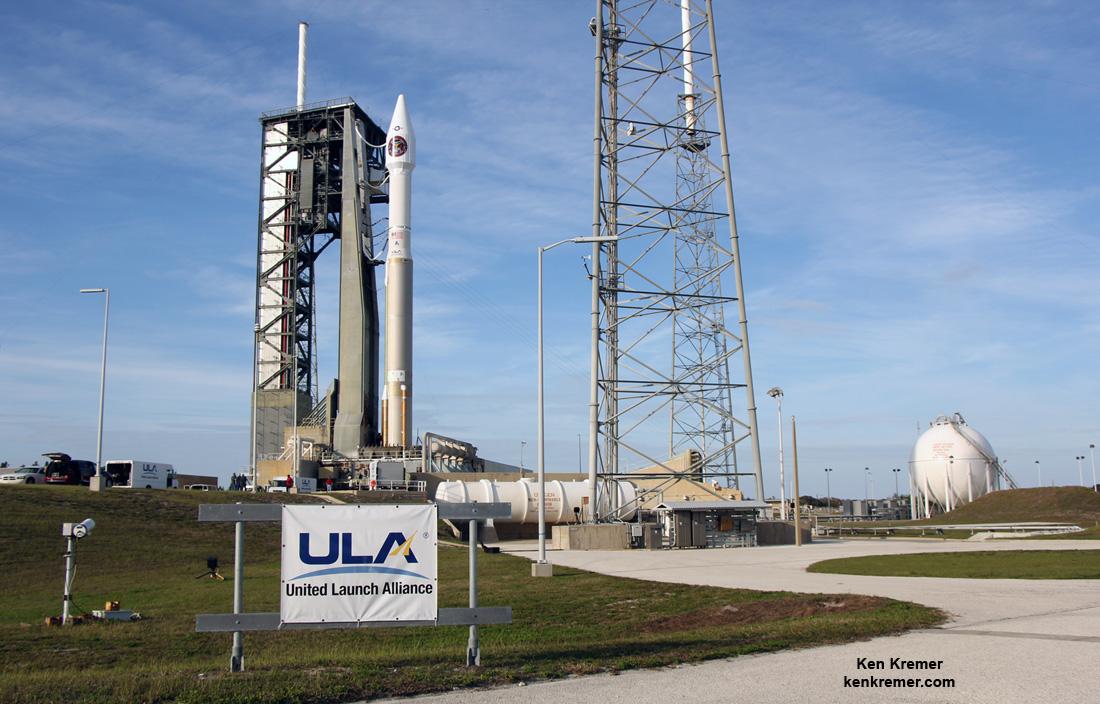
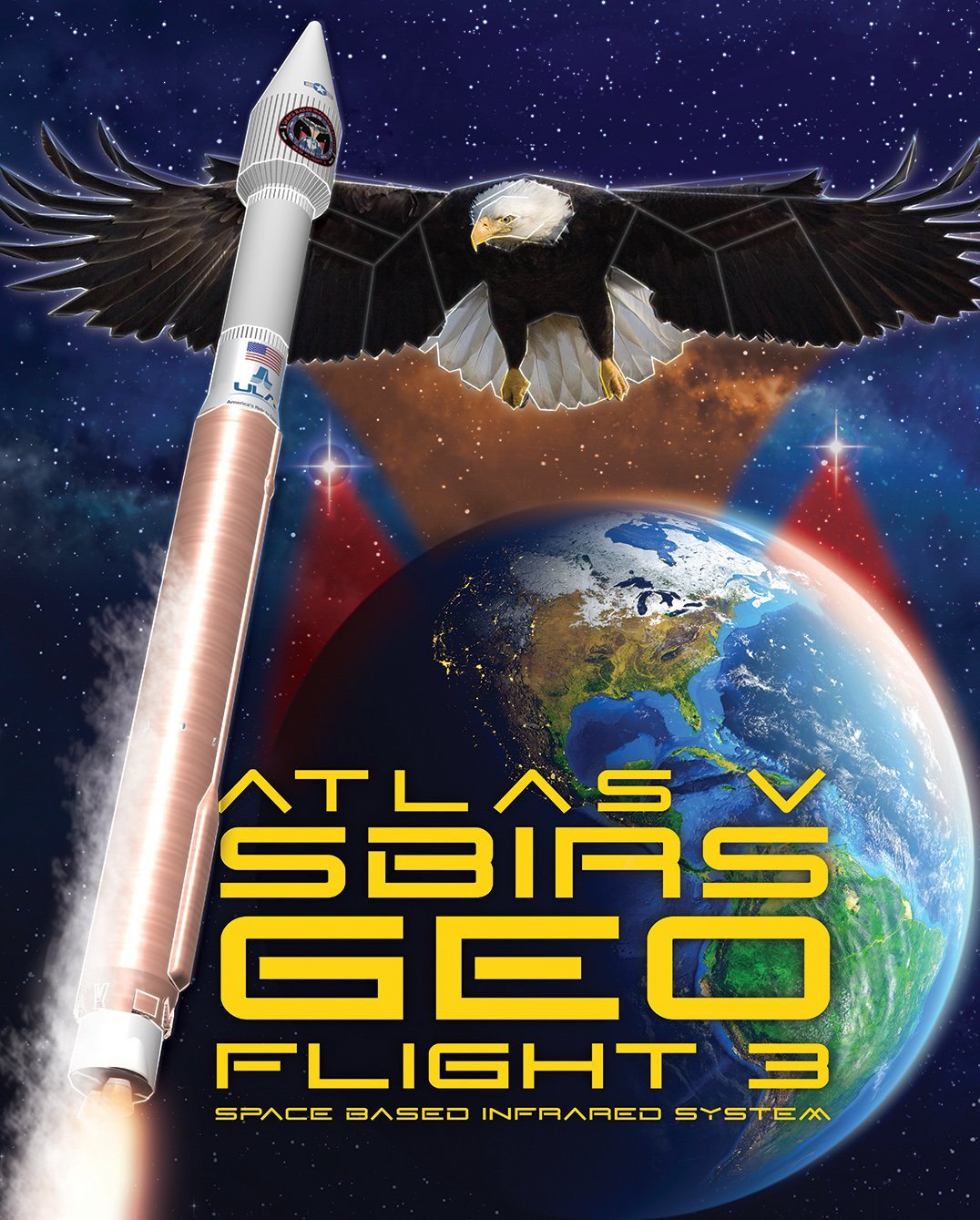
Boeing Starts Assembly of 1st Flightworthy Starliner Crew Taxi Vehicle at Kennedy Spaceport
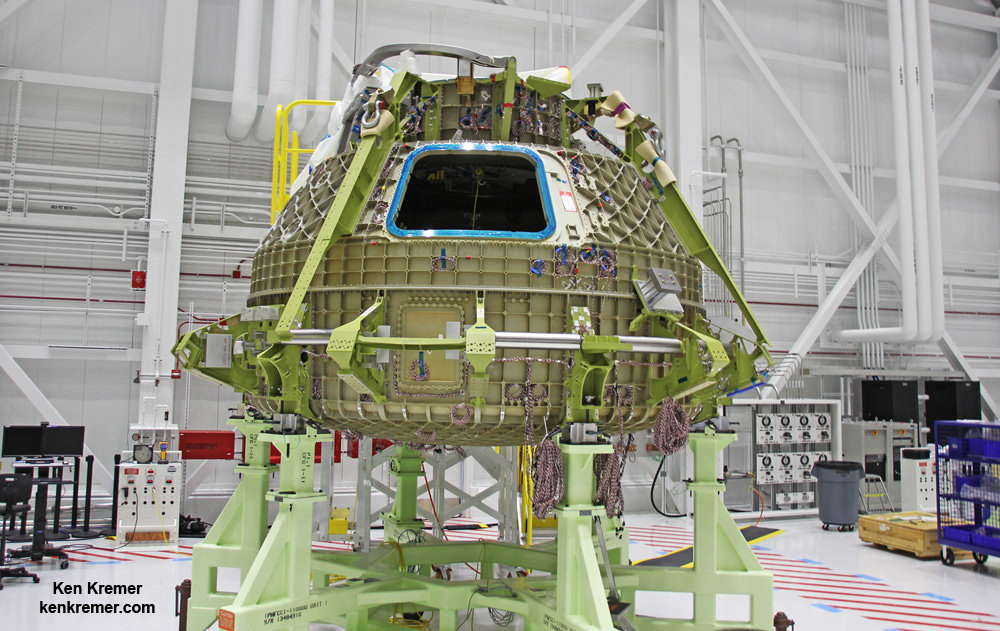

KENNEDY SPACE CENTER, FL – The next generation of America’s human spaceships is rapidly taking shape and “making fantastic progress” at the Kennedy Space Center as Boeing and NASA showcased the start of assembly of the first flightworthy version of the aerospace giants Starliner crew taxi vehicle to the media last week. Starliner will ferry NASA astronauts to and from the International Space Station (ISS) by early 2018.
“We are making fantastic progress across the board,” John Mulholland, vice president and program manager of Boeing Commercial Programs, told Universe Today at the July 26 media event in Boeing’s new Starliner factory.
“It so nice to move from design to firm configuration, which was an incredibly important milestone, to now moving into the integrated qual phase of the campaign.”
Boeing is swiftly making tangible progress towards once again flying Americans astronauts to space from American soil as was quite visibly demonstrated when the firm showed off their spanking new Starliner ‘clean-floor factory’ to the media last week, including Universe Today – and it’s already humming with activity by simultaneously building two full scale Starliner crew vehicles.
“We are on track to support launch by the end of 2017 [of the uncrewed orbital test flight],” Mulholland told me.
“The Structural Test Article (STA) crew module is almost ready to be delivered to the test site in California. The service module is already delivered at the test site. So we are ready to move into the qualification campaign.”
“We are also in the middle of component qualification and qualifying more than one component every week as we really progress into assembly, integration and test of flight design spacecrafts.”
Starliner is being manufactured in what is officially known as Boeing’s Commercial Crew and Cargo Processing Facility (C3PF) at the Kennedy Space Center in Florida under contract with NASA’s Commercial Crew Program (CCP).
And the Boeing CST-100 Starliner assembly line aiming to send our astronauts to low Earth orbit and the space station is now operating full speed ahead at KSC.
Formerly known as Orbiter Processing Facility-3, or OPF-3, the facility was previously used as a servicing hanger to prepare NASA’s space shuttle orbiters for flight.
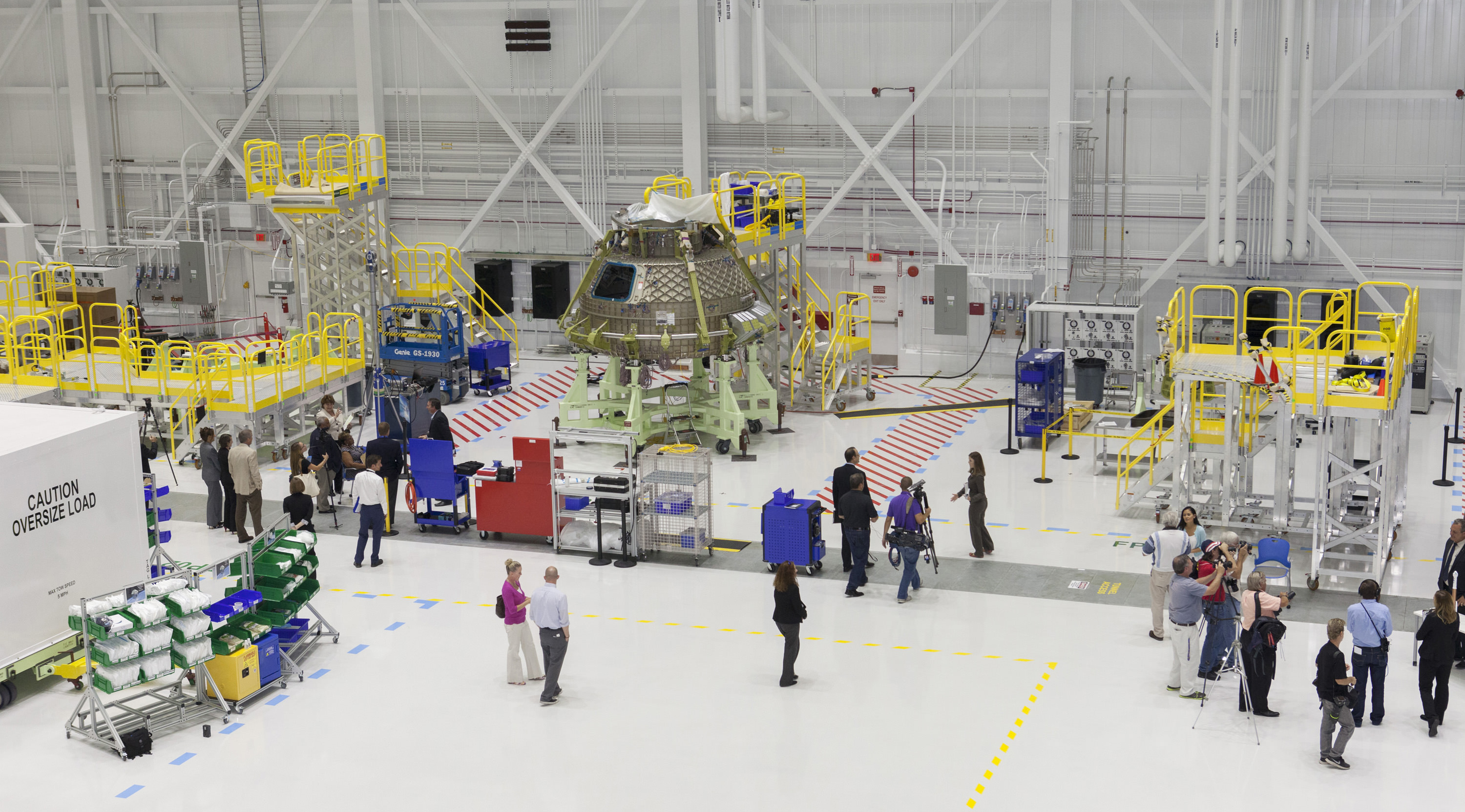
The facility has now been completely renovated and refurbished by removing about 11,000 tons of massive steel work platforms that once enshrouded the space shuttle orbiters for servicing and refurbishment for flight – and been transformed into Boeings gleaming white C3PF Starliner manufacturing facility.
Components for the first Starliner that will actually fly in space – known as Spacecraft 1 – began arriving recently at the C3PF. These include the upper and lower domes, as well as the docking hatch for the spacecrafts pressure vessel.
“You can see the beginning of Spacecraft 1. To build it all of the major structural elements are here,” Mulholland explained.
“The lower dome will be populated and get to first power on early next year. We are really looking forward to that. Then we will mate that to the upper dome and start in on the ground qualification on Spacecraft 1.”
Altogether Boeing is fabricating three Starliner flight spacecraft.
“We will start building Spacecraft 2 in the Fall of this year. And then we will start Spacecraft 3 early next year.”
“So we will have three Starliner spacecraft flight crew module builds as we move into the flight campaign.”
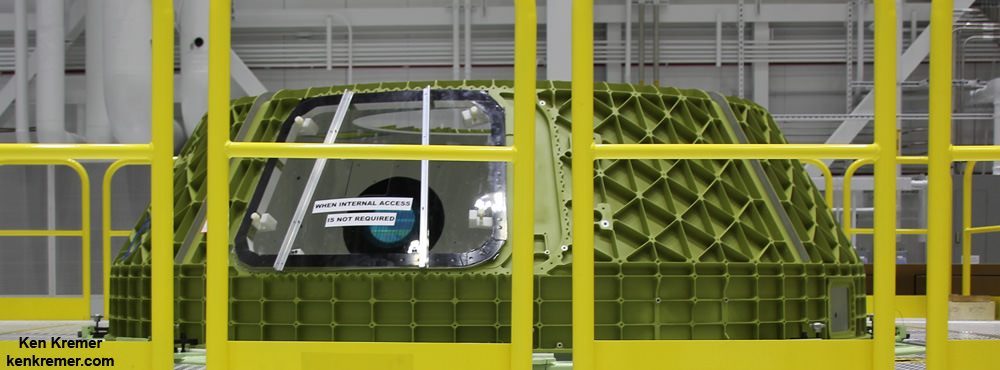
Technicians are outfitting these individual components of the pressure vessel with wiring and lines, avionics and other systems, before they are bolted together.
Spacecraft 1 is actually the second Starliner being manufactured at the Kennedy Space Center.
The first full scale Starliner vehicle to be built is known as the Structural Test Article (STA) and is nearing completion.
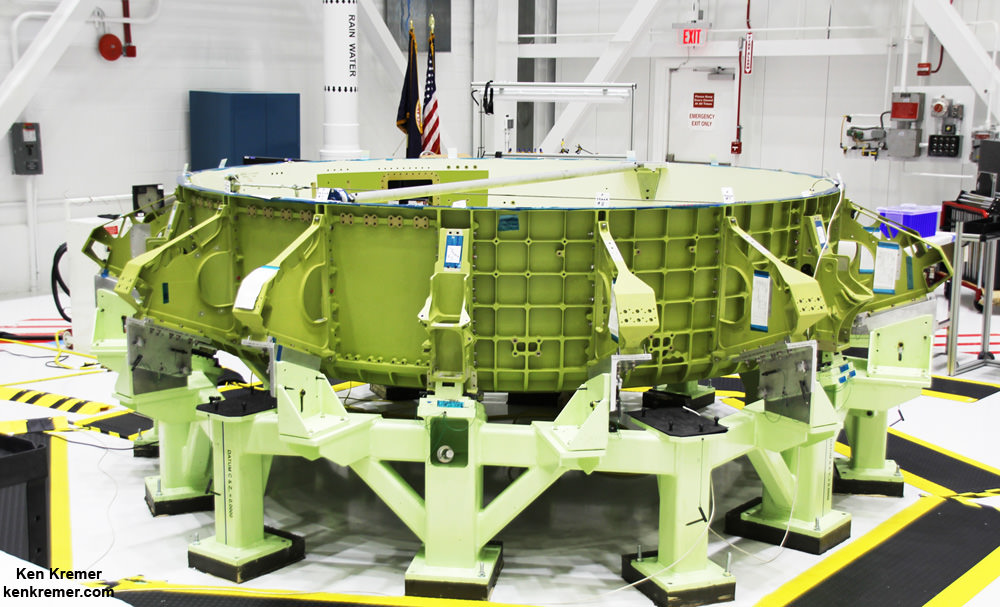
Notably Spacecraft 1 will be the first Starliner to fly in the company’s pad abort test.
“Spacecraft 1 will go into the ground campaign and then the pad abort,” Mulholland stated.
“The test is designed to prove the launch abort system planned for the spacecraft will be able to lift astronauts away from danger in the event of an emergency during launch operations,” says NASA.
The Pad Abort test is currently slated for October 2017 in New Mexico. Boeing will fly an uncrewed orbital flight test in December 2017 and a crewed orbital flight test in February 2018.
“Spacecraft 3 will be the first to fly in orbit on the uncrewed flight test by the end of 2017,” Mulholland confirmed.
‘Spacecraft 2 will go through a several month long thermal vac testing and EMI and EMC in California in the middle of next year and then go into the crewed flight test [in 2018].”
The rather distinctive, olive colored aluminum domes are manufactured using a weldless spin forming process by Spincraft, based in North Billerica, Massachusetts.
They take on their honeycombed look after being machined for the purposes of reducing weight and increasing strength to handle the extreme stresses of spaceflight. The lower dome is machined by Janicki Industries in Layton, Utah, and the upper dome is machined by Major Tool & Machine in Indianapolis.
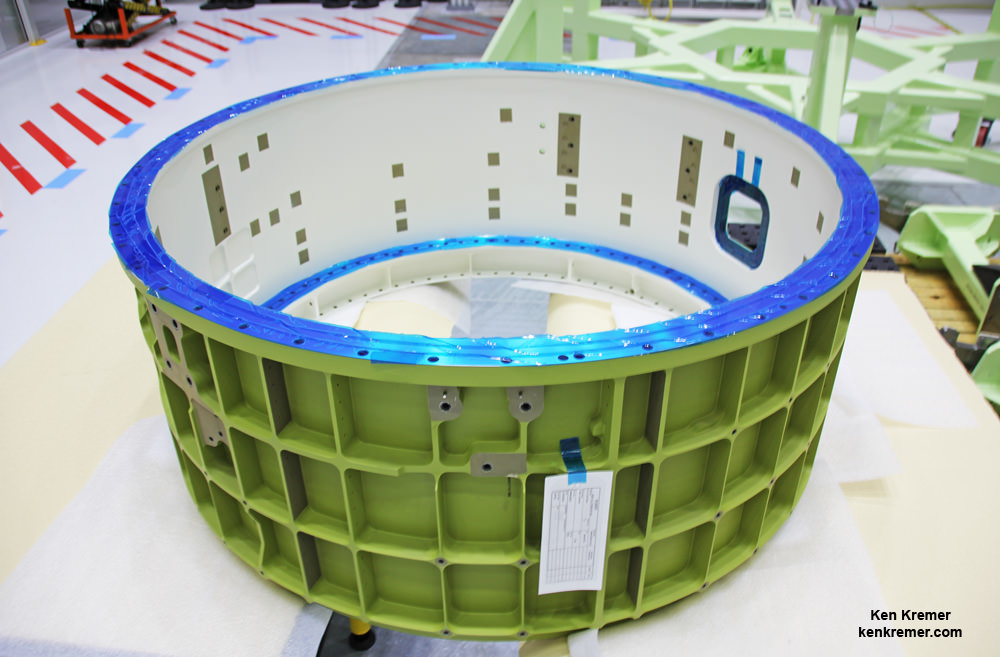
Engineers bolted together the upper and lower domes of Boeings maiden Starliner crew module in early May to form the complete hull of the pressure vessel for the Structural Test Article (STA).
Altogether they are held together by 216 bolts. They have to line up perfectly. And the seals are checked to make sure there are no leaks, which could be deadly in space.
Boeing expects to finish fabricating the STA by August.
The completed Starliner STA will then be transported to Boeing’s facility in Huntington Beach, California for a period of critical stress testing that verifies the capabilities and worthiness of the spacecraft.
“Boeing’s testing facility in Huntington Beach, California has all the facilities to do the structural testing and apply loads. They are set up to test spacecraft,” said Danom Buck, manager of Boeing’s Manufacturing and Engineering team at KSC, during an interview in the C3PF.
“At Huntington Beach we will test for all of the load cases that the vehicle will fly in and land in – so all of the worst stressing cases.”
“So we have predicted loads and will compare that to what we actually see in testing and see whether that matches what we predicted.”
Boeing has also vastly updated the mockup Starliner to reflect the latest spacecraft advances and assist in manufacturing the three planned flight units.
Bastian Technologies built many of the components for the mockup and signed as new 18-month new Mentor-Protégé Program agreement with Boeing and NASA at the media event.
The mock up “is used as a hands-on way to test the design, accessibility and human factors during the early design and development phase of the program. The mock-up is currently being used for rapid fire engineering verification activities, ergonomic evaluations [including the seats and display panels], and crew ingress and egress training,” says NASA.
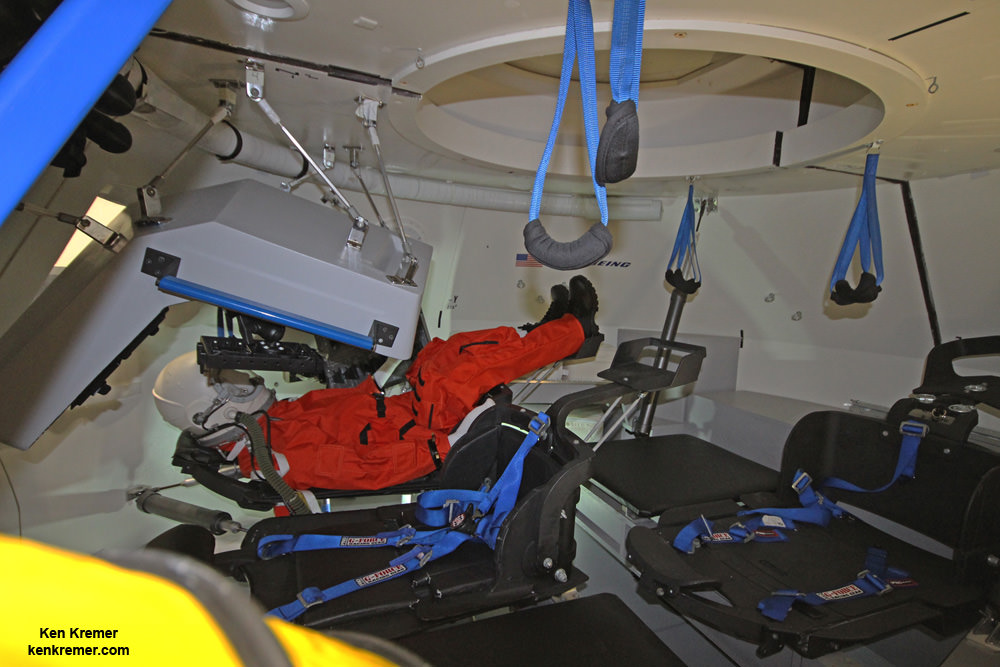
The Boeing CST 100 Starliner is one of two private astronaut capsules – along with the SpaceX Crew Dragon – being developed under a commercial partnership contract with NASA to end our sole reliance on Russia for crew launches back and forth to the International Space Station (ISS).
The goal of NASA’s Commercial Crew Program (CCP) is to restore America’s capability to launch American astronauts on American rockets from American soil to the ISS, as soon as possible.
Boeing was awarded a $4.2 Billion contract in September 2014 by NASA Administrator Charles Bolden to complete development and manufacture of the CST-100 Starliner space taxi under the agency’s Commercial Crew Transportation Capability (CCtCap) program and NASA’s Launch America initiative.
Since the retirement of NASA’s space shuttle program in 2011, the US was been 100% dependent on the Russian Soyuz capsule for astronauts rides to the ISS at a cost exceeding $70 million per seat.
Starliners will launch to space atop the United Launch Alliance (ULA) Atlas V rocket from pad 41 on Cape Canaveral Air Force Station in Florida.
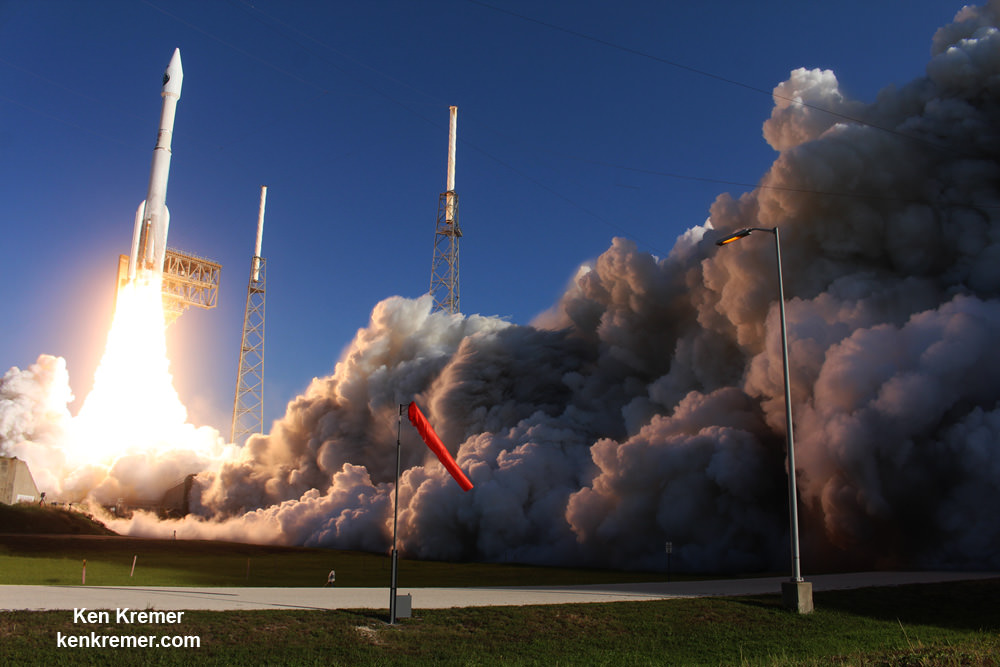
Stay tuned here for Ken’s continuing Earth and planetary science and human spaceflight news.
Ken Kremer
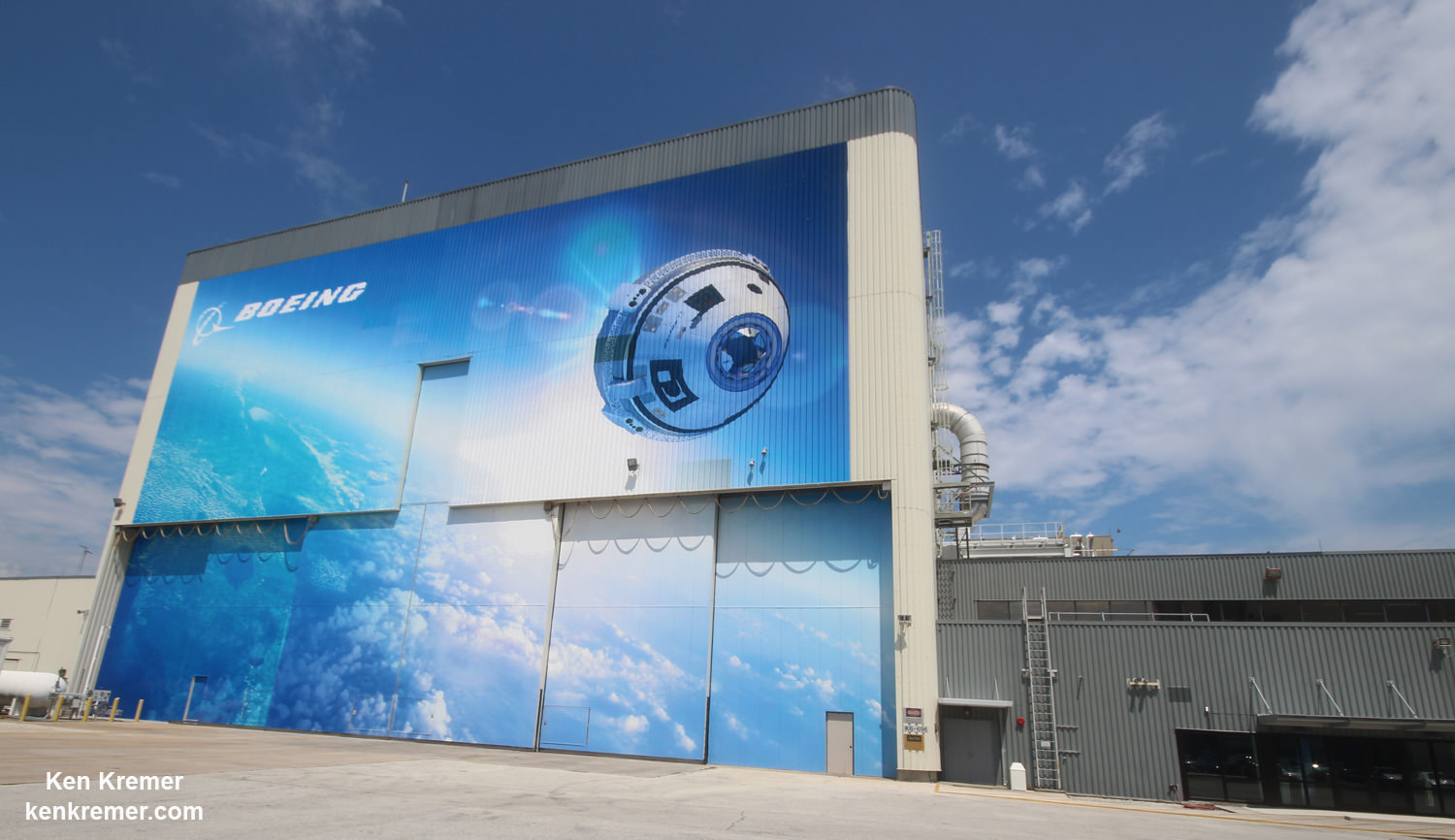
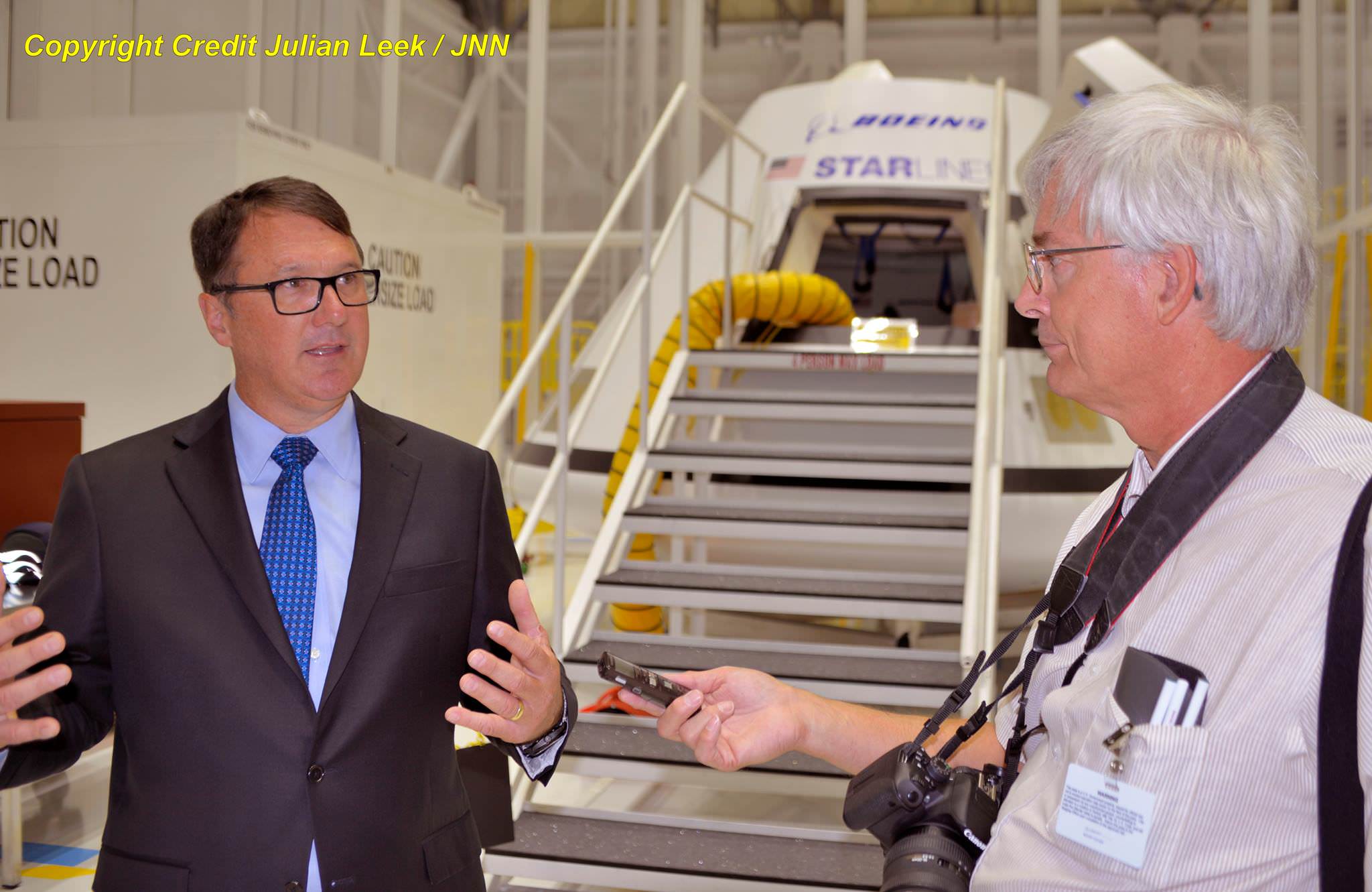
Fuel Control Valve Faulted for Atlas Launch Anomaly, Flights Resume Soon


A critical fuel control valve has been faulted for the Atlas V launch anomaly that forced a premature shutdown of the rockets first stage engines during its most recent launch of a Cygnus cargo freighter to the International Space Station (ISS) last month – that nevertheless was successful in delivering the payload to its intended orbit.
Having identified the root cause of the engine shortfall, workers for Atlas rocket builder United Launch Alliance (ULA), have now stacked the booster slated for the next planned liftoff in the processing facility at their Cape Canaveral launch pad, the company announced in a statement Friday.
The Atlas rockets Centaur upper stage fired longer than normal after the first stage anomaly, saving the day by making up for the significant lack of thrust and “delivering Cygnus to a precise orbit, well within the required accuracy,” ULA said.
ULA says it hopes to resume launches of the 20 story tall rocket as soon as this summer, starting with the MUOS-5 communications satellite payload for the U.S. Navy.
Following a painstaking investigation to fully evaluate all the data, the ULA engineering team “determined an anomaly with the RD-180 Mixture Ratio Control Valve (MRCV) assembly caused a reduction in fuel flow during the boost phase of the flight,” the company confirmed in a statement.
The Atlas V first stages are powered by the Russian-made RD AMROSS RD-180 engines. The dual nozzle powerplants have been completely reliable in 62 Atlas launches to date.
The RD-180s are fueled by a mixture of RP-1 kerosene and liquid oxygen stored in the first stage.
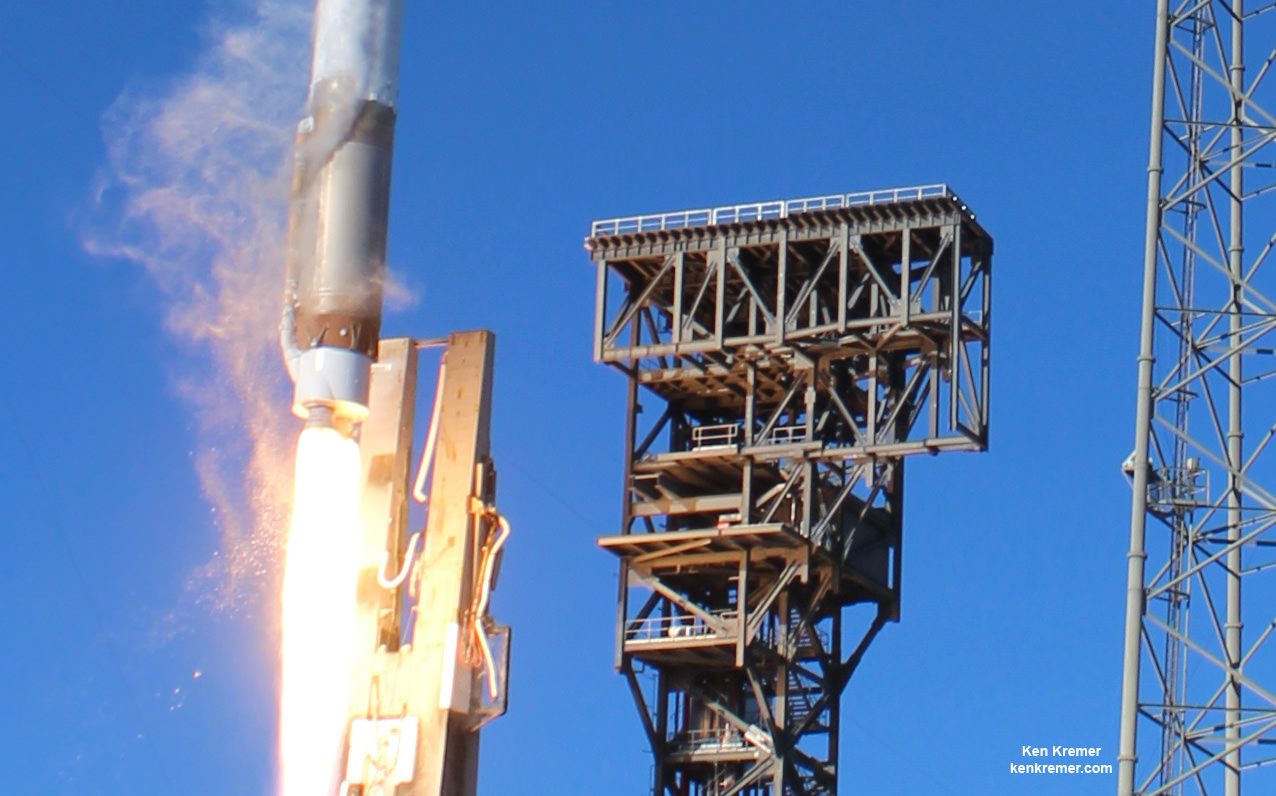
The Centaur RL10C-1 second stage powerplant had to make up for a thrust and velocity deficiency resulting from a 6 second shorter than planned firing of the first stage RD-180 engines.
“The Centaur [upper stage] burned for longer than planned,” Lyn Chassagne, ULA spokesperson, told Universe Today.
Indeed Centaur fired for a minute longer than planned to inject Cygnus into its proper orbit.
“The first stage cut-off occurred approximately 6 seconds early, however the Centaur was able to burn an additional approximately 60 seconds longer and achieve mission success, delivering Cygnus to its required orbit,” said ULA.
MUOS-5 was originally supposed to blastoff on May 5. But the liftoff was put on hold soon after the Atlas V launch anomaly experienced during the March 22, 2016 launch of the Orbital ATK Cygnus OA-6 supply ship to the ISS for NASA.
Since then, ULA mounted a thorough investigation to determine the root cause and identify fixes to correct the problem with RD-180 Mixture Ratio Control Valve (MRCV) assembly, while postponing all Atlas V launches.
ULA has inspected, analyzed and tested their entire stockpile of RD-180 engines.
Last Friday, the Atlas V first stage for the MUOS-5 launch was erected inside ULA’s Vertical Integration Facility (VIF) at Space Launch Complex-41 on Cape Canaveral Air Force Station, Florida. The five solid motors have been attached and the Centaur is next.
In this configuration, known as Launch Vehicle on Stand (LVOS) operation, technicians can further inspect and confirm that the RD-180 engines are ready to support a launch.
The two stage Atlas V for MUOS-5 will launch in its most powerful 551 configuration with five solid rocket boosters attached to the first stage, a single engine Aerojet Rocketdyne RL10C-1 Centaur upper stage and a 5-meter-diameter payload fairing.
The RD-180s were supposed to fire for 255.5 seconds, or just over 4 minutes. But instead they shut down prematurely resulting in decreased velocity that had to be supplemented by the Centaur RL10C-1 to get to the intended orbit needed to reach the orbiting outpost.
The liquid oxygen/liquid hydrogen fueled Aerojet Rocketdyne RL10C-1 engine was planned to fire for 818 seconds or about 13.6 minutes. The single engine produces 22,900 lbf of thrust.
The Atlas V first and second stages are preprogrammed to swiftly react to a wide range of anomalous situations to account for the unexpected. The rocket and launch teams conduct countless simulations to react to off nominal situations.
“The Atlas V’s robust system design, software and vehicle margins enabled the successful outcome for this mission,” Chassagne said.
“As with all launches, we will continue to focus on mission success and work to meet our customer’s needs.”
ULA currently sports a year’s long manifest of future Atlas V launches in the pipeline. It includes a wide range of payloads for NASA, US and foreign governments, and military and commercial customers – all of who are depending on ULA maintaining its string of 106 straight launches with a 100% record of success since the company formed in 2006.
The Orbital ATK Cygnus CRS-6 space freighter was loaded with 3513 kg (7700 pounds) of science experiments and hardware, crew supplies, spare parts, gear and station hardware for the orbital laboratory in support of over 250 research experiments being conducted on board by the Expedition 47 and 48 crews.
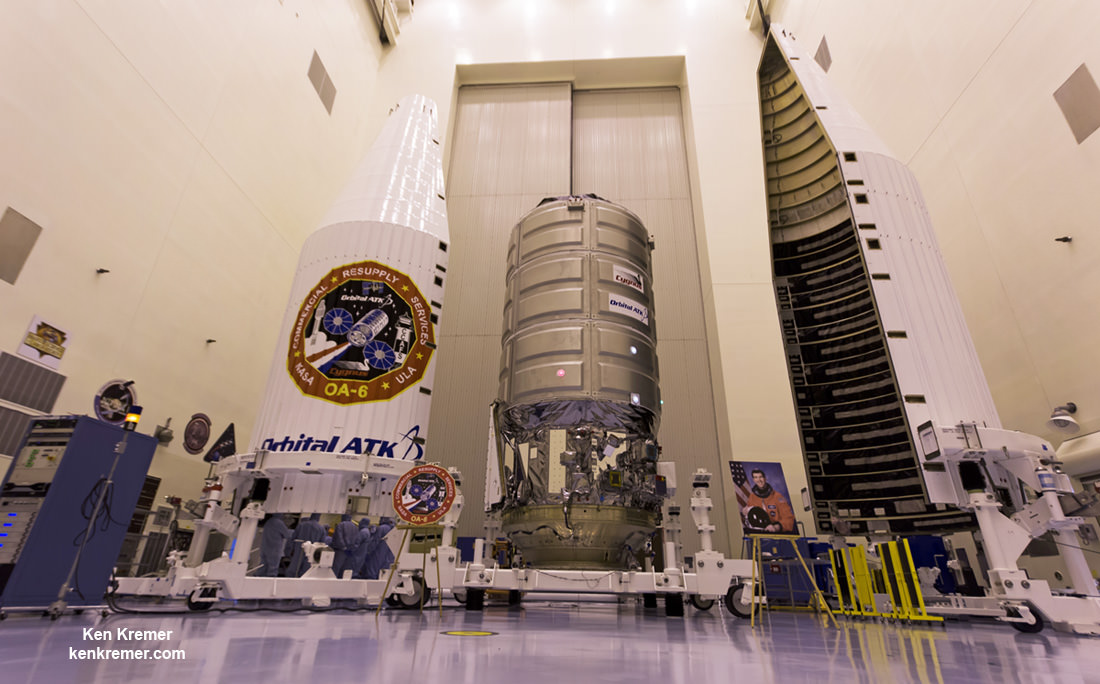
Cygnus successfully arrived and berthed at the ISS on March 26 as planned.
An exact date for the MUOS-5 launch has yet to be confirmed on the Eastern Range with the US Air Force.
ULA is in the process of coordinating launch dates with customers for their remaining Atlas V launches in 2016.
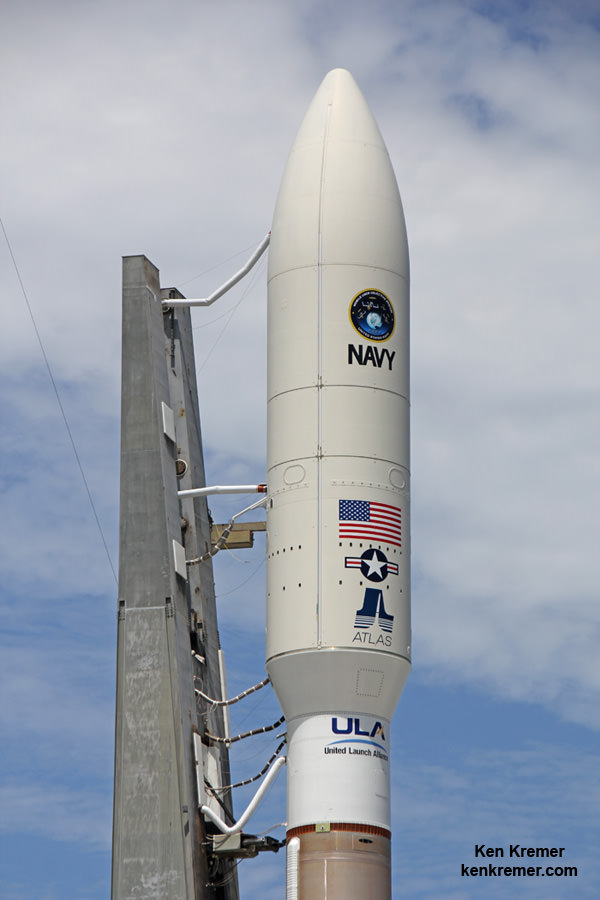
The 15,000 pound MUOS payload is a next-generation narrowband tactical satellite communications system designed to significantly improve ground communications for U.S. forces on the move.
ULA says they expect minimal impact and foresee completing all launches planned for 2016, including the top priority OSIRIS-REx asteroid mission for NASA which has a specific launch window requirement.

Stay tuned here for Ken’s continuing Earth and planetary science and human spaceflight news.



